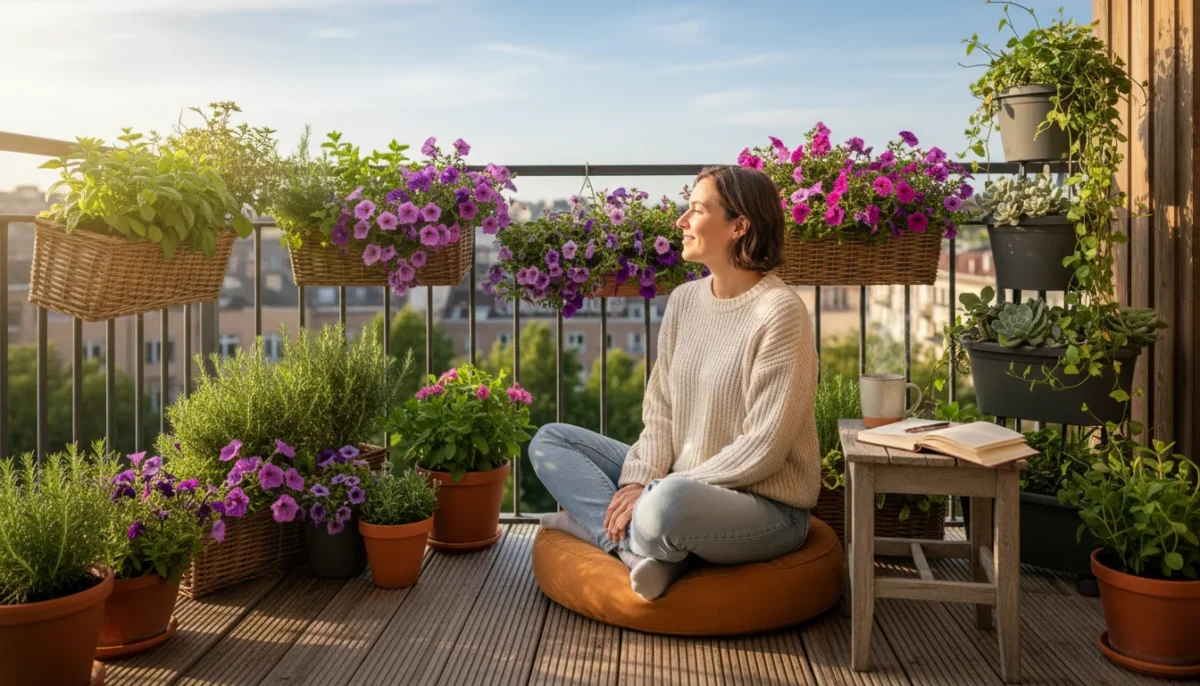Your balcony, patio, or compact yard offers more than just outdoor space. It represents an incredible opportunity to extend your living area, creating a true outdoor room. Instead of a collection of scattered pots, envision a cohesive, inviting space that functions as an integral part of your home. This approach transforms a simple gardening spot into an outdoor living space, enhancing your enjoyment and potentially even your property value.
Designing a balcony garden to feel like a room requires thoughtful planning, much like decorating an indoor space. You define zones, choose furniture, select a color palette, and consider lighting. The key lies in applying interior design principles to your outdoor area, making it feel intentional, comfortable, and beautiful. This guide equips you with practical, actionable insights to achieve that harmonious balance, focusing on small-space solutions and low-maintenance strategies. We will help you create a container design that provides beauty and functionality, allowing you to relax and thrive in your personalized green oasis.
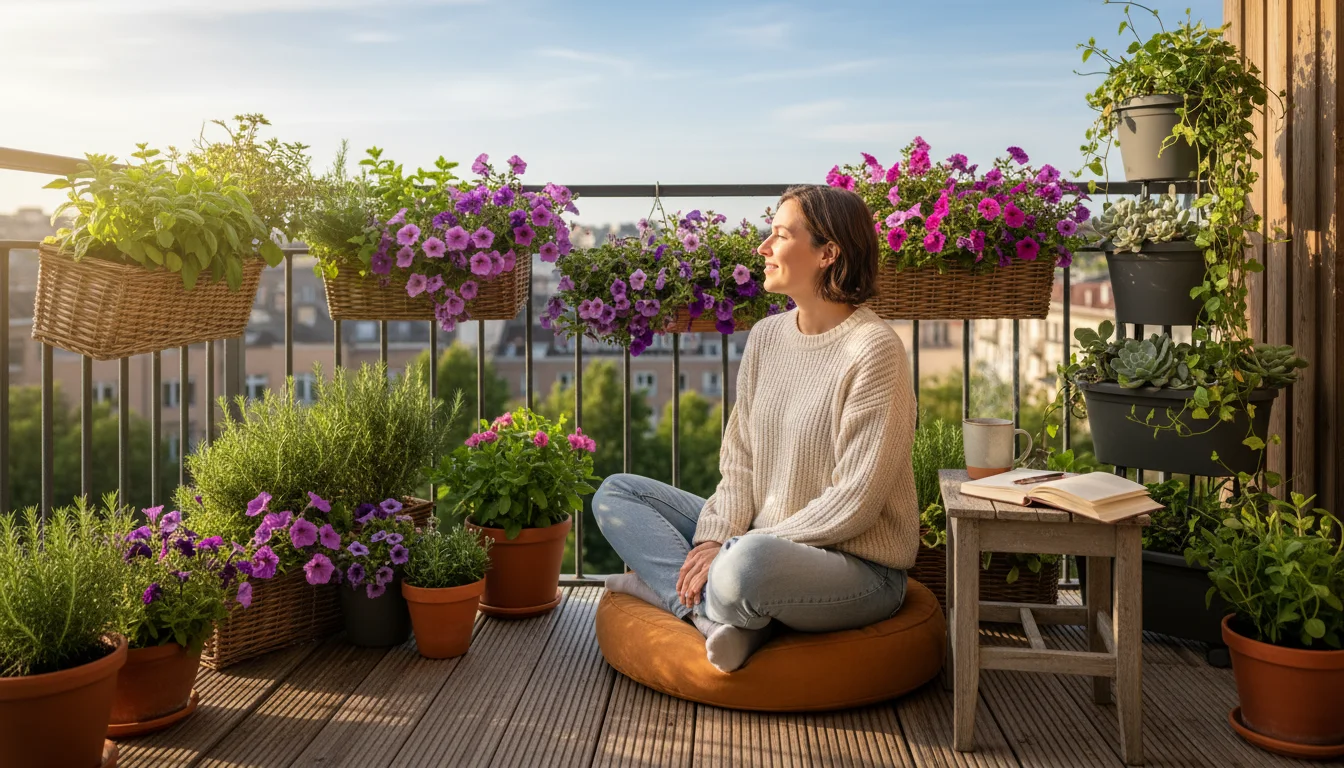
Envisioning Your Outdoor Room: Starting with Purpose
Before you choose a single plant or pot, define the primary purpose of your balcony garden. This initial step shapes every subsequent design decision. Are you dreaming of a tranquil reading nook, an al fresco dining spot, a lively entertaining area, or a productive edible garden? Your answer dictates the type of furniture, the necessary clearances, and even the plant choices you make.
Begin by asking yourself a few key questions:
- What activities do you want to do here? Consider relaxing with a coffee, dining with a partner, working on a laptop, practicing yoga, or simply enjoying the quiet.
- How many people will typically use the space? This impacts seating arrangements and table sizes.
- What time of day will you use it most? Morning sun might call for different plant choices than afternoon shade. Evening use necessitates effective lighting.
- What is your current view like? Do you want to enhance a pleasant vista or screen an unsightly one?
- What is your budget? Set realistic expectations for furniture, containers, and plants.
- How much maintenance are you willing to commit? Be honest about the time and effort you can realistically dedicate to watering, pruning, and general care. This will heavily influence your plant selection and irrigation strategy.
For example, if you envision a peaceful retreat, you might prioritize comfortable seating, soft lighting, and fragrant plants. If dining is your goal, a sturdy table, comfortable chairs, and maybe some culinary herbs become central. Documenting these preferences provides a clear roadmap for your balcony garden design, ensuring the final result truly feels like an extension of your indoor life.
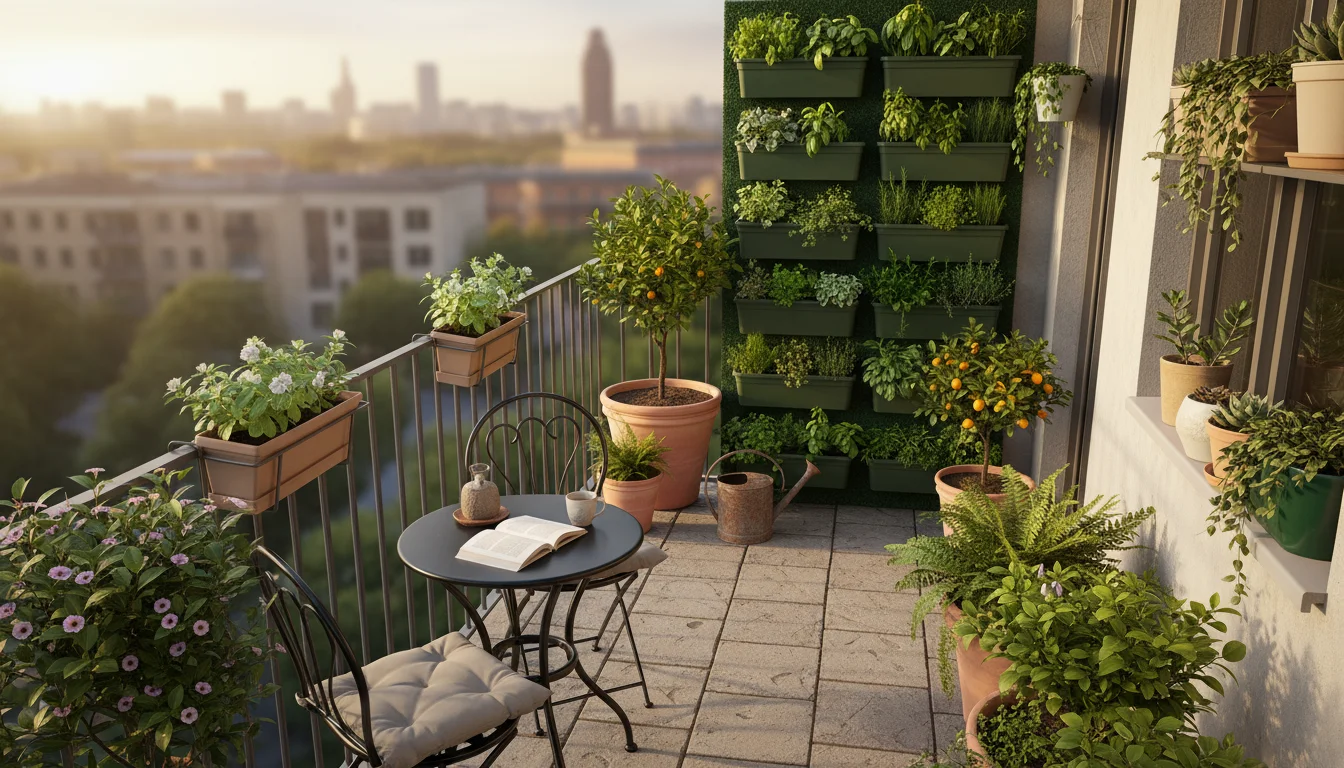
Small-Space Layouts and Zoning: Defining Your Balcony’s Function
Even the smallest balcony benefits from strategic layout planning, much like an efficient kitchen or cozy bedroom. The goal is to define functional areas, or “zones,” that serve your desired activities while maintaining clear circulation. This thoughtful approach prevents a cluttered look and maximizes usability.
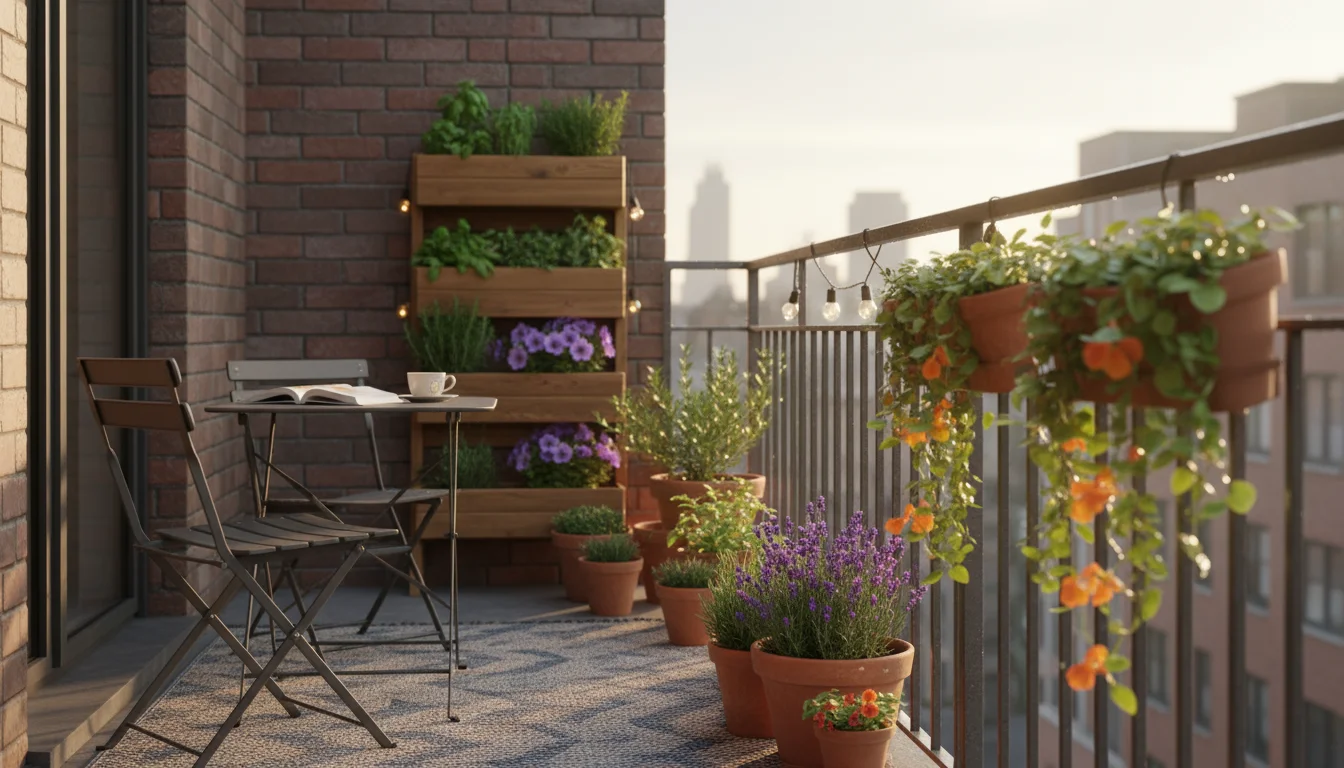
Defining Zones
Mentally divide your balcony into distinct areas. A typical small balcony might feature two primary zones:
- The Living/Seating Zone: This is where you place your furniture. Choose pieces scaled to your space. Bistro sets, compact loveseats, or foldable chairs work well. Ensure comfortable seating forms the core of your outdoor room.
- The Planting Zone: This area holds your containers, trellises, and vertical gardens. It provides the lush backdrop and green ambiance.
For larger spaces, you might add a third zone for storage, a small water feature, or even a compact grilling station. The key is to avoid overstuffing your balcony. Less is often more in small spaces.
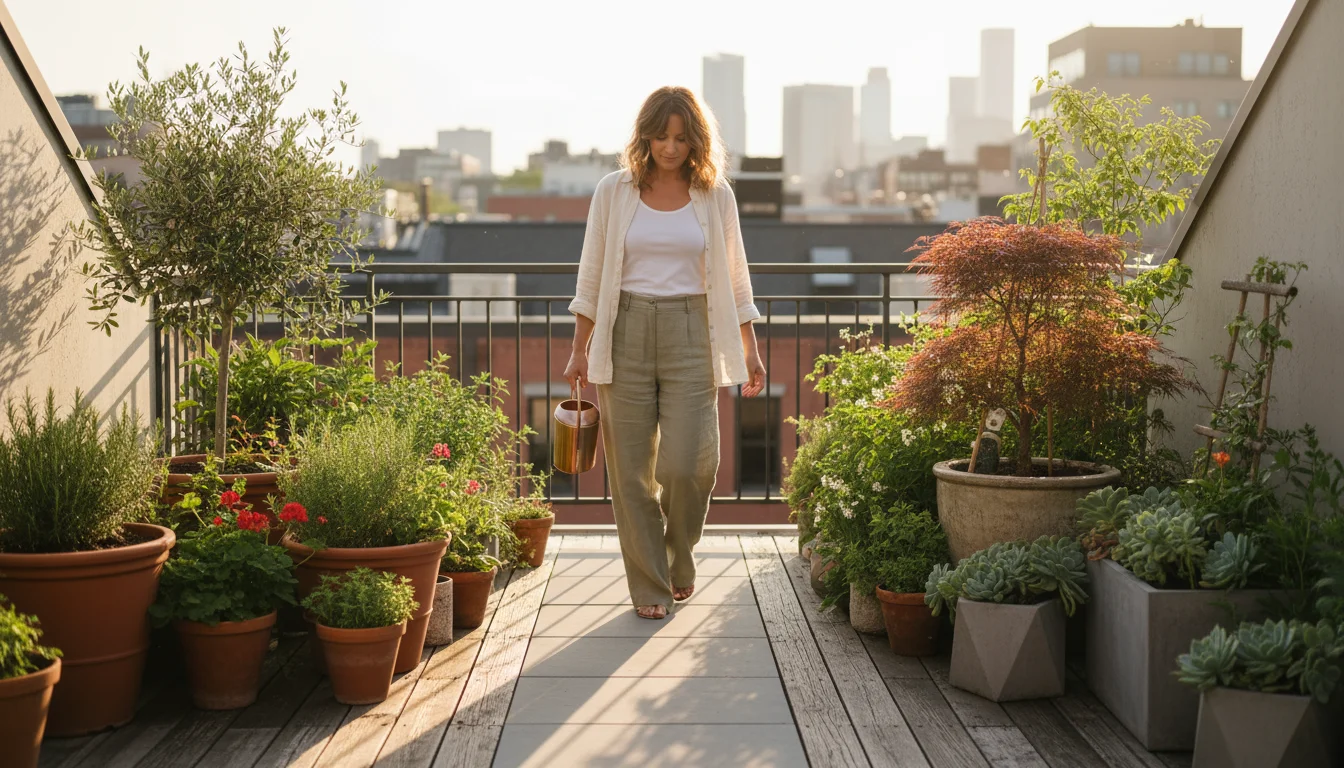
Ensuring Smooth Traffic Flow
Just as you navigate your home, you need clear paths on your balcony. Obstructions make a space feel cramped and unwelcoming. Aim for a minimum of 24 to 30 inches (60-75 cm) for comfortable passage between furniture pieces and planting areas. Test your layout by walking through it before making permanent decisions. Can you easily access all your plants for watering? Can guests move without bumping into pots?
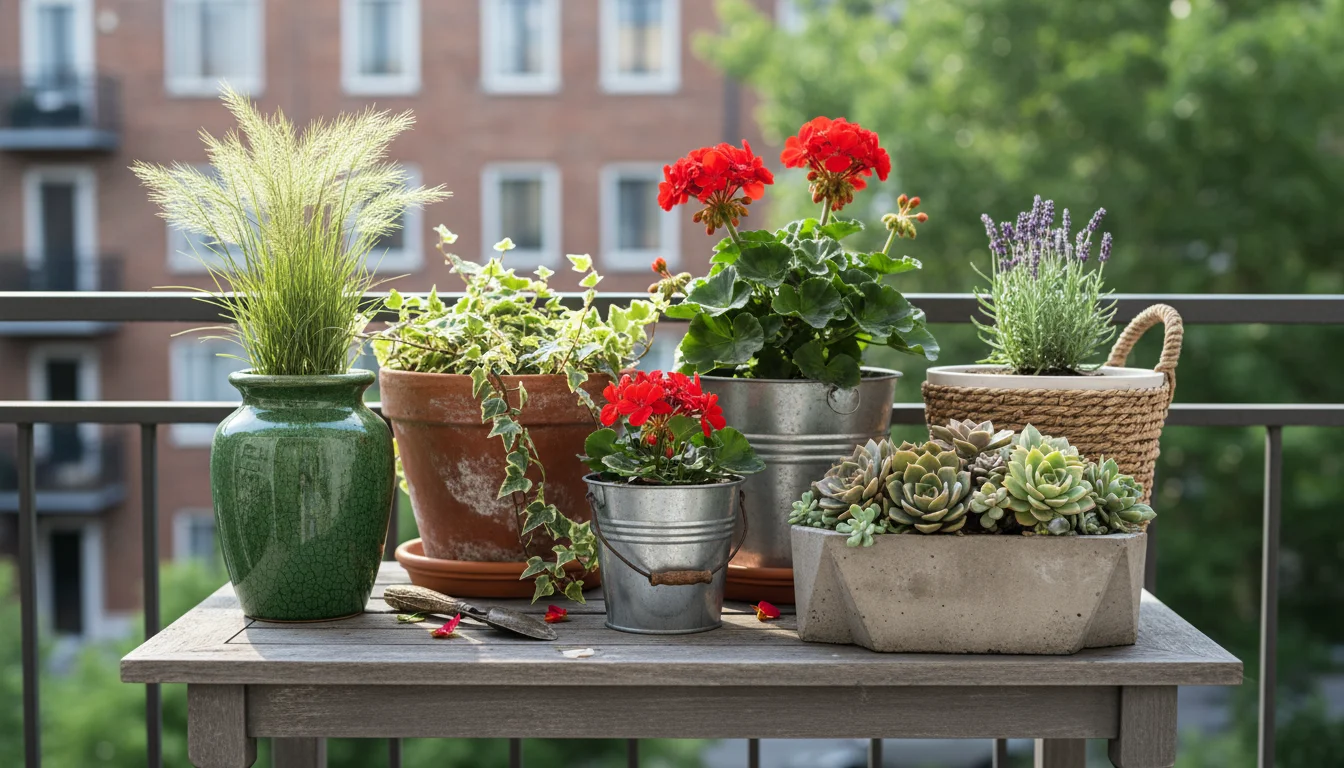
Strategic Container Groupings
Avoid scattering individual pots randomly. Instead, group containers together. Grouping creates visual impact and makes watering more efficient. Think of these groupings as mini-arrangements or vignettes. For a balanced, aesthetically pleasing look, gardeners often group containers in odd numbers, such as three or five. Vary the heights and sizes within each grouping to add dynamism and depth, preventing a flat, uninteresting display.
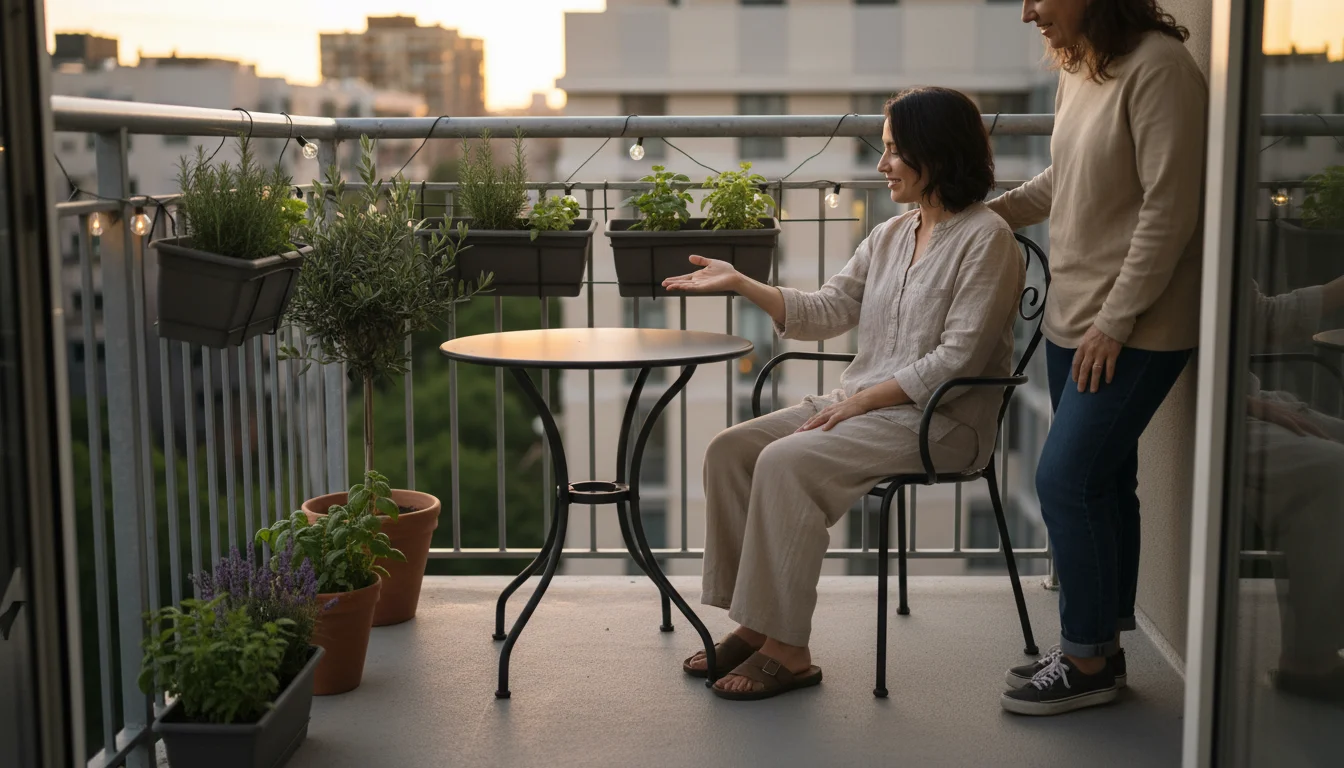
Seating Clearances
Consider the space you need around seating. If you have a table, allow at least 18 to 24 inches (45-60 cm) from the table edge to the back of a chair for comfortable dining. For lounge chairs, ensure enough space to fully recline or extend your legs without hitting a plant or railing. Planning these clearances ensures your outdoor room feels genuinely functional, not just decorative.
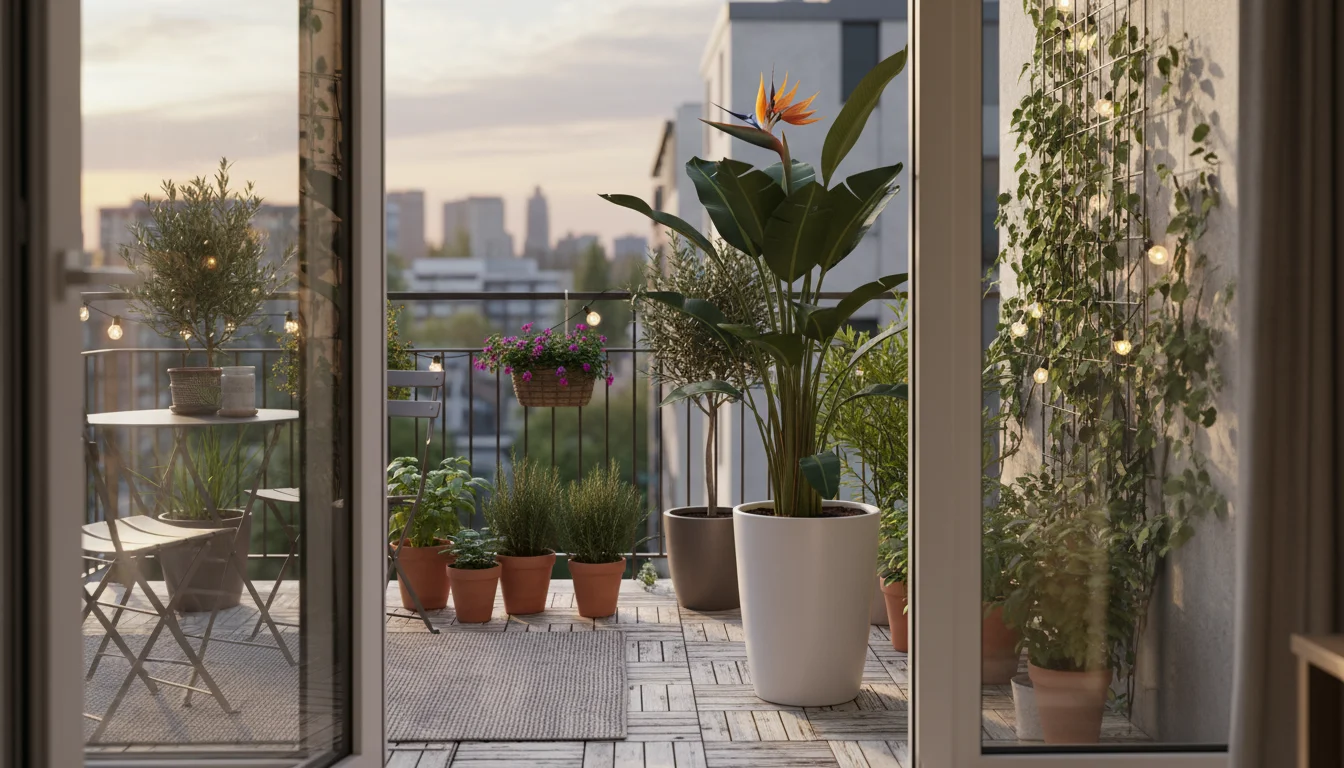
Focal Points and Sightlines: Guiding the Eye
Every well-designed room, indoors or out, benefits from a focal point. This is the first thing your eye notices upon entering the space, or when looking out from your indoor living area onto the balcony. A strong focal point provides visual interest, anchors the design, and prevents the space from feeling chaotic or undefined.
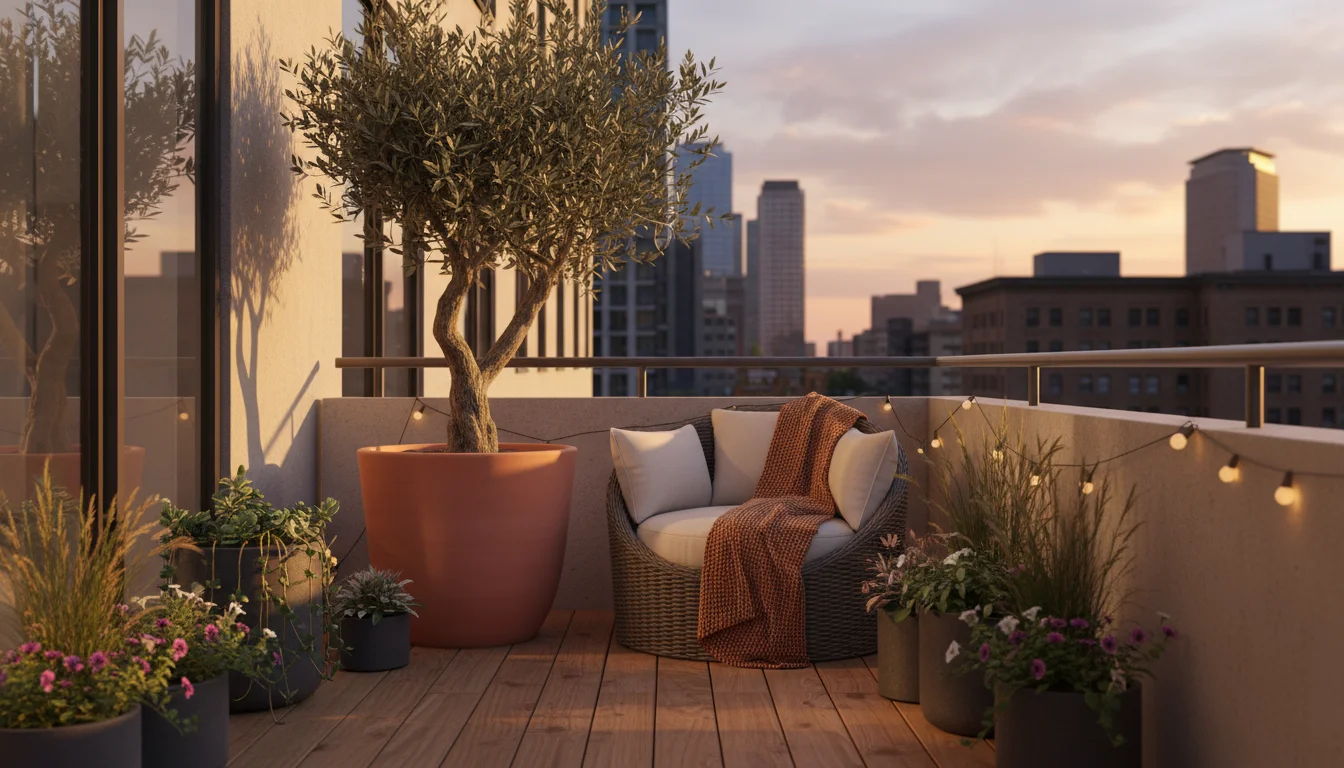
Creating Your Balcony’s Star Attraction
Your focal point could be:
- A striking plant: A tall, architectural plant like a dwarf bamboo, an olive tree, or a vibrant bougainvillea.
- A piece of art: A weather-resistant sculpture, a unique wall hanging, or a decorative mirror.
- A water feature: A small, recirculating fountain offers both visual appeal and a soothing sound element.
- A comfortable seating arrangement: A stylish chair with inviting cushions, positioned to overlook a pleasant view.
Position your chosen focal point strategically. It should draw the eye without overwhelming the small space. Often, placing it at the far end of a narrow balcony creates a sense of depth and makes the space appear longer.
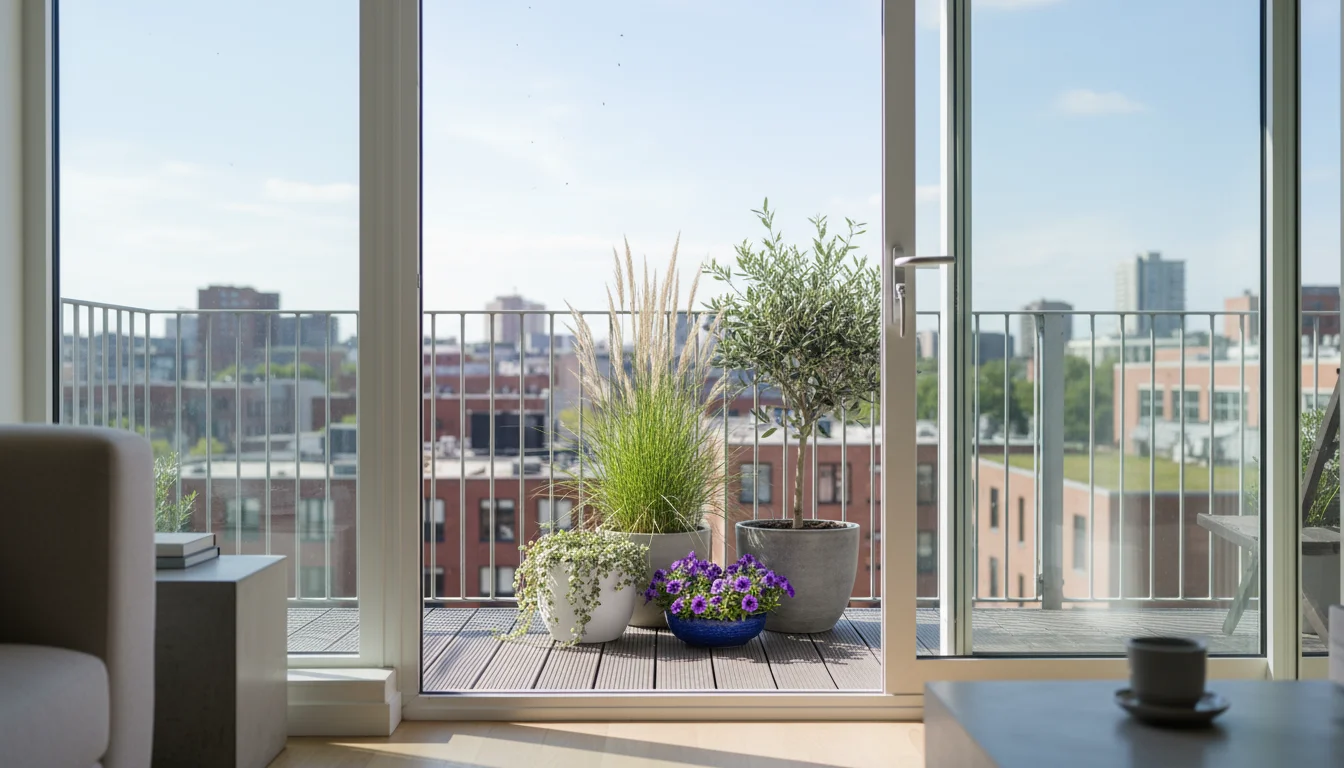
Designing from the Inside Out
Consider how your balcony garden looks from inside your home. This internal view is often your most frequent interaction with the space, especially during cooler months. Design the balcony to be an attractive visual extension of your interior. Place a beautiful container grouping, a captivating plant, or a piece of outdoor art directly in line with a window or door, ensuring a pleasant view year-round.
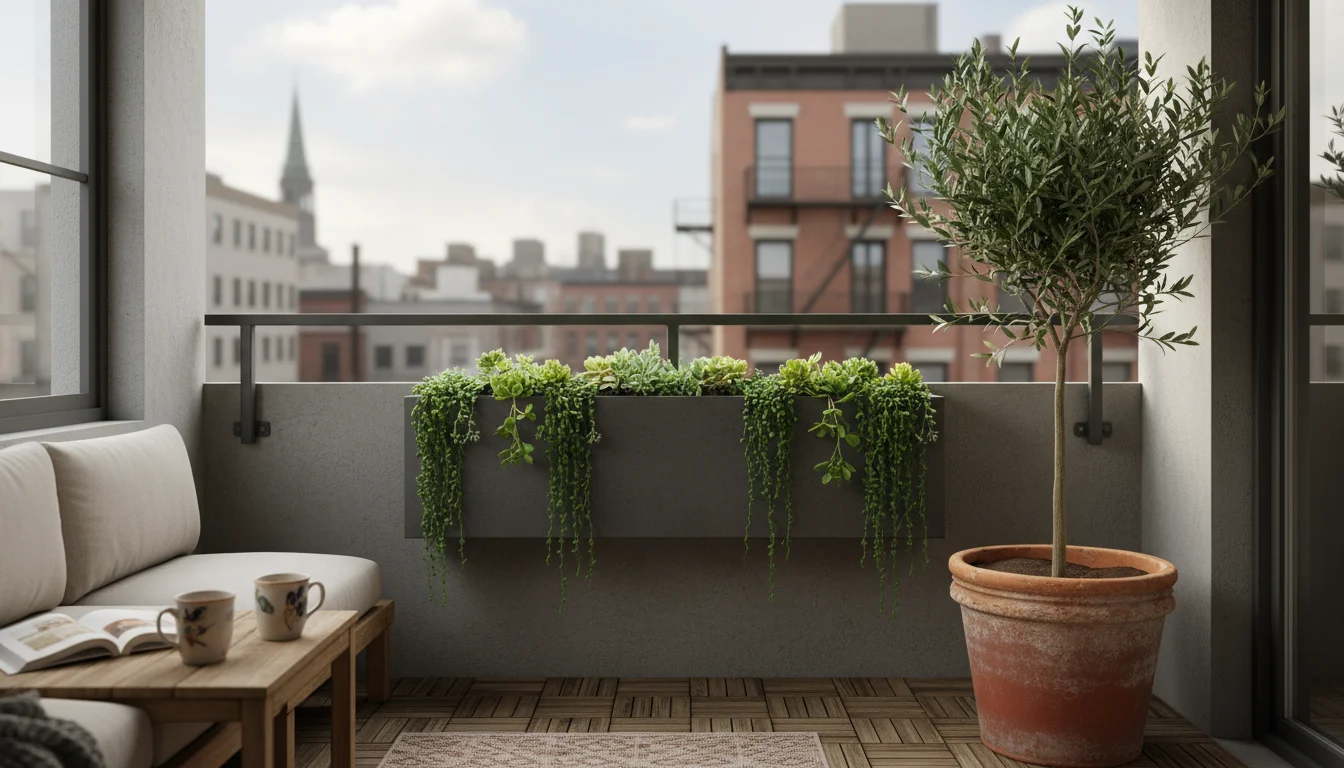
Eye-Level Anchors
While floor-level pots are essential, incorporating elements at eye level adds another layer of interest. Use wall-mounted planters, hanging baskets, or tall containers to bring plants up. This not only creates vertical interest but also helps define the “walls” of your outdoor room. An eye-level plant or decorative element can act as a secondary anchor, drawing attention and enhancing the room-like feel.
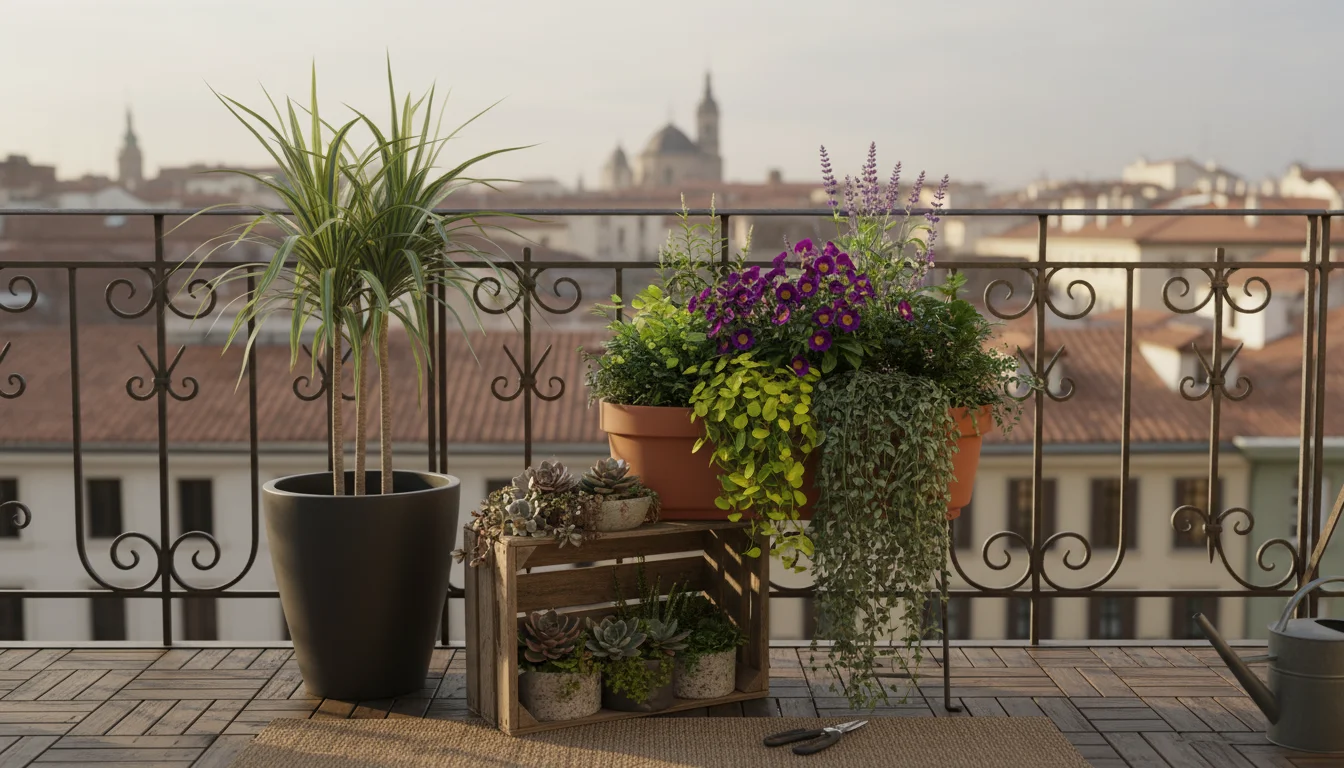
Symmetry Versus Asymmetry
You can approach your layout with either symmetry or asymmetry, depending on your desired aesthetic:
- Symmetry: Achieves a formal, balanced, and orderly look. Place identical or similar elements on opposite sides of a central axis, for example, two matching tall planters flanking a doorway or a bench. Symmetry brings a sense of calm and structure, making a small space feel more composed.
- Asymmetry: Creates a more natural, dynamic, and relaxed feel. It balances elements of different sizes, shapes, and textures to achieve equilibrium without mirroring. For instance, a tall, slender plant on one side could balance a wider, lower grouping of pots on the other. Asymmetry adds visual intrigue and can make a small space feel less rigid.
Neither approach is inherently superior; the best choice depends on the architectural style of your home and your personal taste. Whatever you choose, ensure balance so the space does not feel lopsided.
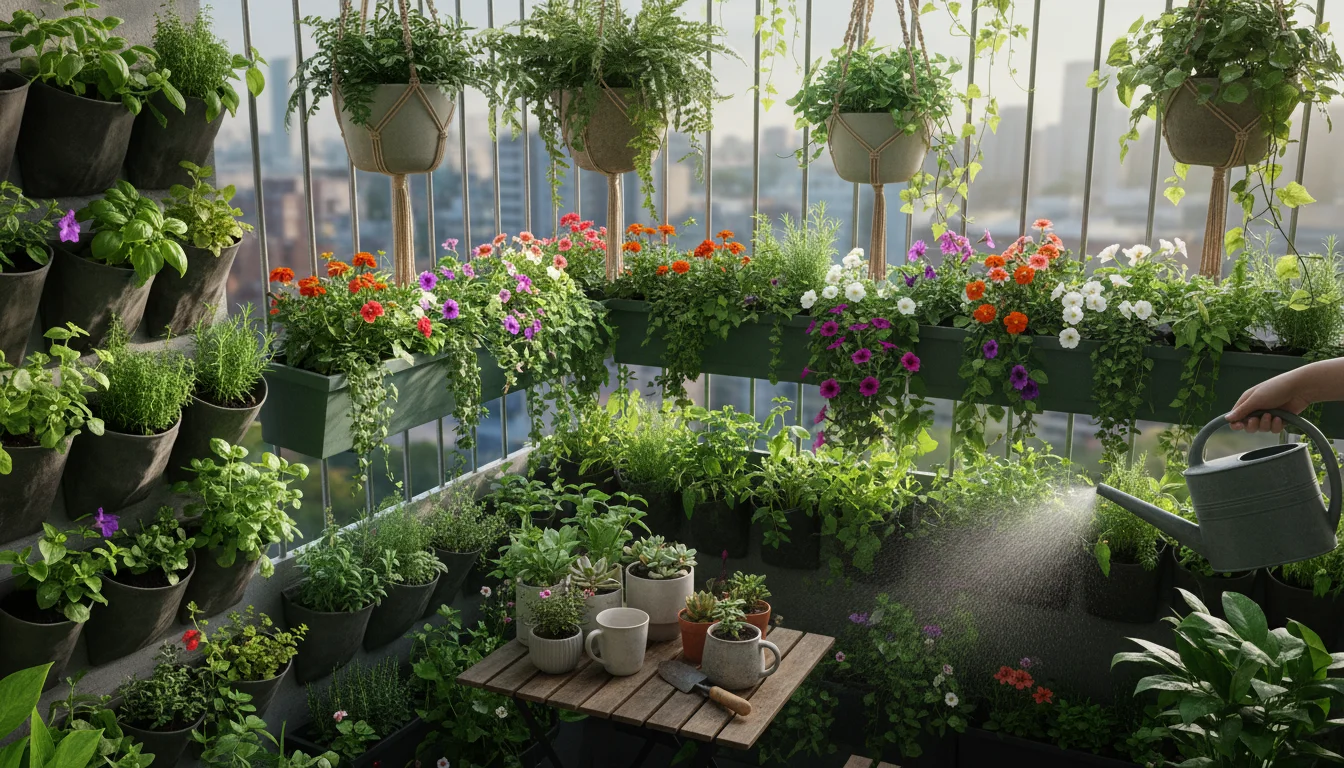
Vertical Gardening and Layering: Maximizing Your Dimensions
In a small outdoor space, thinking vertically is not just an option, it’s a necessity. Your balcony walls, railings, and even the air above your head offer valuable real estate for planting. Harnessing these “third dimensions” allows you to pack more greenery into a compact area, creating a lush, immersive garden that truly feels like a room.
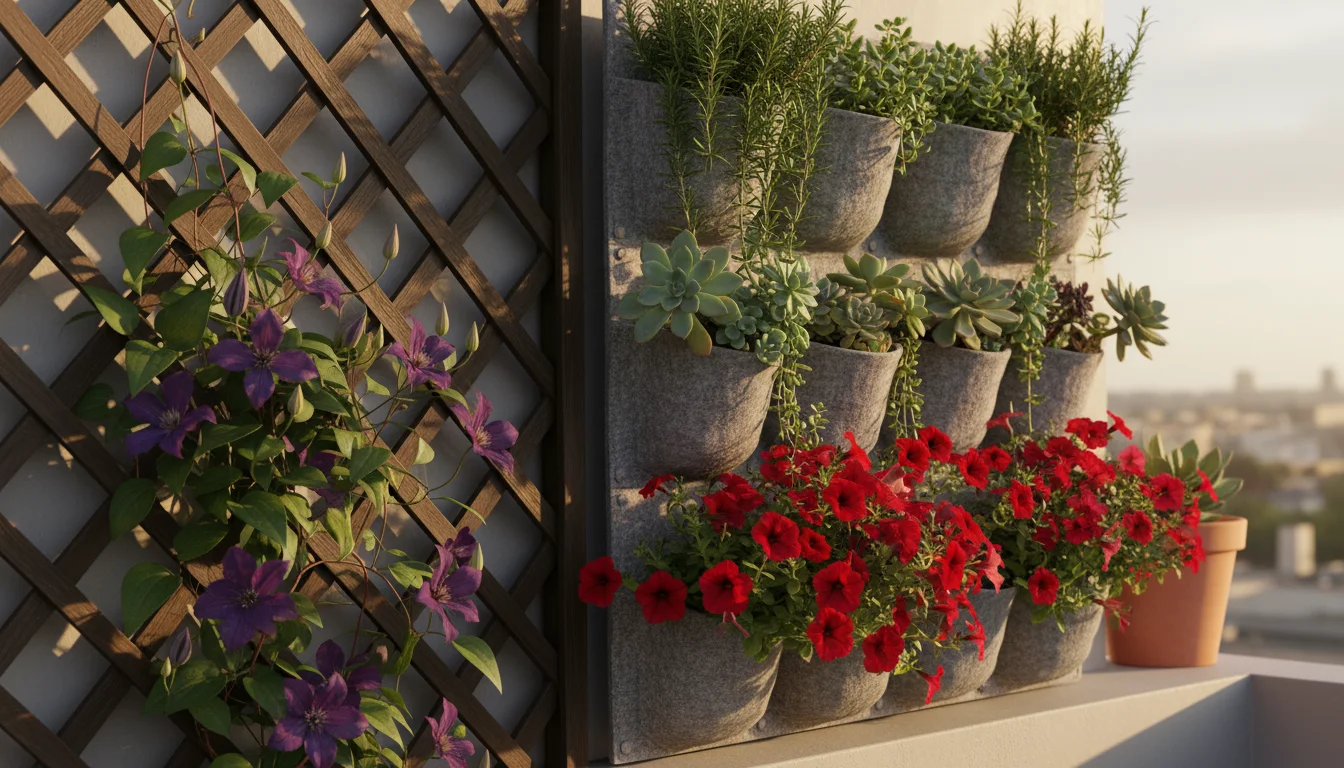
Utilizing Walls with Trellises and Wall Planters
Walls provide an excellent canvas for greenery. Consider these options:
- Trellises: Install a sturdy trellis against a wall or along a railing. Choose fast-growing climbing plants like clematis, jasmine, or edible options like cucumbers or peas. Trellises add height, create living privacy screens, and bring a soft, organic texture to hard surfaces. Ensure your trellis is securely mounted and can support the weight of mature plants.
- Wall Planters: These range from individual pots that hook onto railings or wall grids to elaborate modular pocket systems. Wall planters allow you to grow herbs, small edibles, succulents, or flowering annuals without consuming precious floor space. Arrange them in a pattern or a cascading design for visual impact.
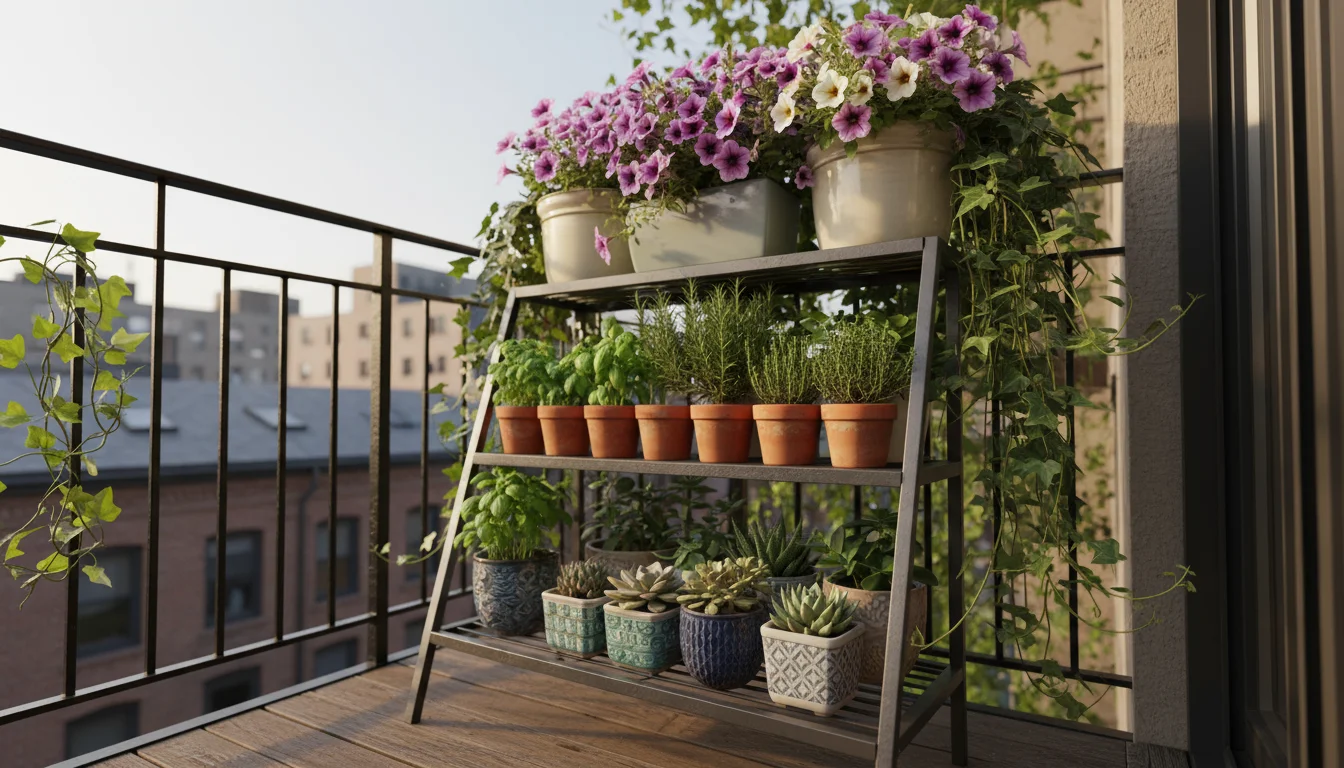
Tiered Stands and Shelving: Elevating Your Plants
Tiered plant stands, shelving units, or even repurposed step ladders offer fantastic ways to display multiple pots in a compact footprint. These structures:
- Add varied heights: They prevent your garden from looking like a flat sea of pots.
- Improve light exposure: Plants on higher tiers receive more light.
- Create visual depth: A tiered arrangement guides the eye up and down, making the space feel more dynamic.
- Maximize planting density: You can place many plants in a small area.
Choose stands made from durable, weather-resistant materials like powder-coated metal, treated wood, or robust plastic. Ensure stability, especially if you live in a windy area.
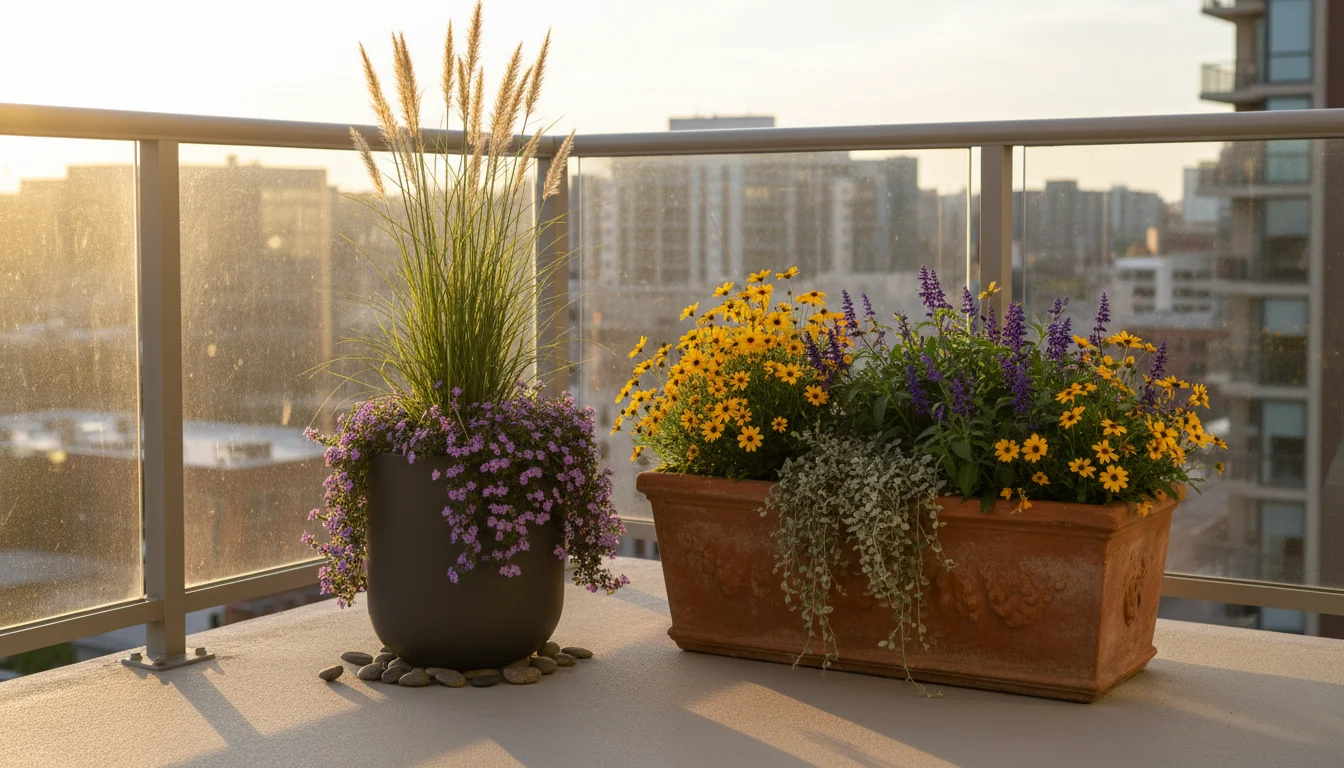
Height Transitions: Building Visual Layers
Think of your balcony garden in layers, much like a natural landscape or a well-arranged floral display. This technique creates a sense of depth and makes the space feel larger and more inviting. Combine plants of varying heights:
- Tall Layer (Thrillers): These are your vertical anchors. Think upright grasses, small trees, or climbers on trellises. They form the “walls” and ceiling of your outdoor room.
- Mid-Layer (Fillers): Bushy, mounding plants that fill the space between the tall elements and the ground. These provide volume and continuity.
- Low Layer (Spillers): Trailing plants that cascade over the edges of pots or hang from baskets. They soften hard lines and add a luxurious, overflowing feel.
By intentionally varying the heights of your plants and containers, you create a rich, layered environment that surrounds you, truly embodying the feeling of an outdoor room. This layering also helps to guide the eye through the space, making it feel more expansive and thoughtfully designed.
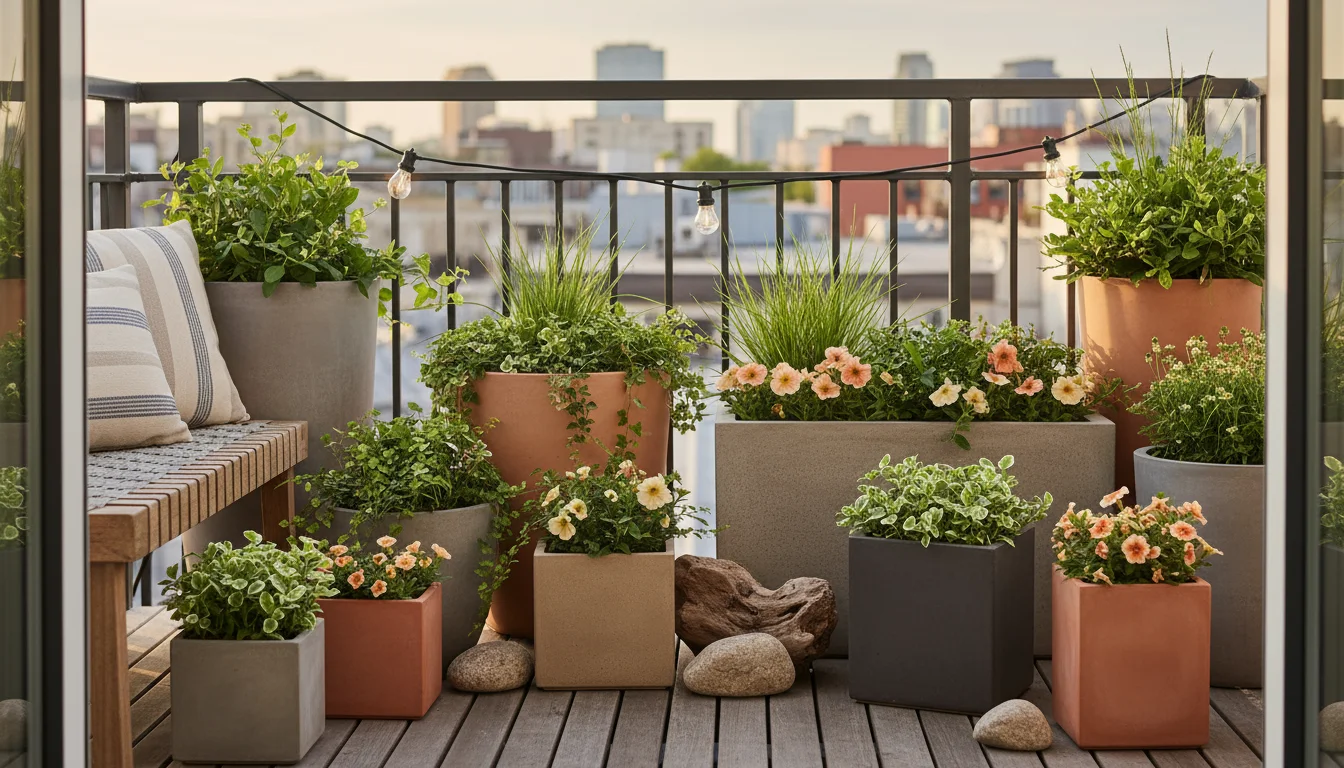
Container Strategy for Cohesion: Unifying Your Design
Your choice of containers profoundly influences the overall aesthetic and success of your balcony garden. It is not just about holding soil; containers are design elements themselves. A cohesive container strategy creates a polished, intentional look, transforming a collection of pots into a unified outdoor living space.
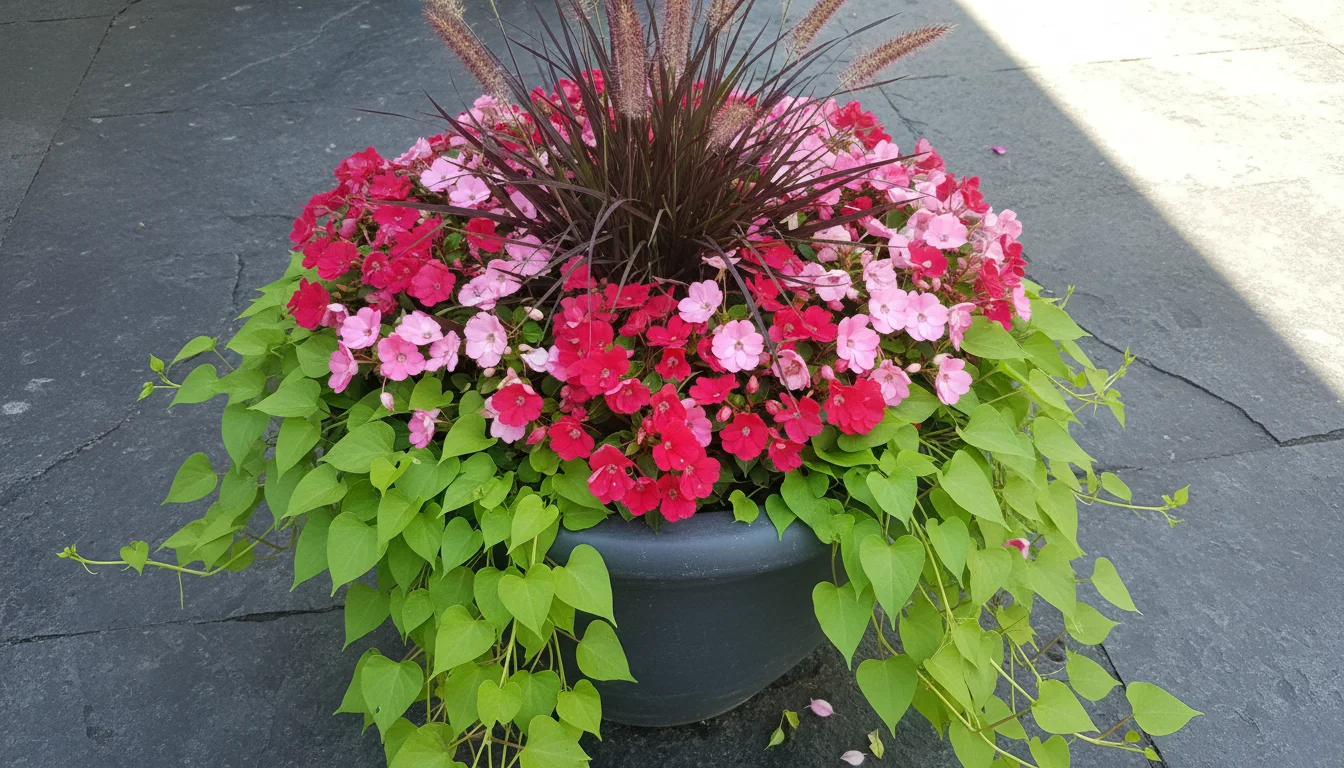
Thoughtful Container Sizes
Do not shy away from large containers, even in small spaces. A few well-chosen large pots create more impact than many small, disparate ones. Large pots offer several practical advantages:
- Stability: They are less likely to tip over in windy conditions.
- Moisture retention: Larger soil volumes dry out slower, reducing watering frequency, which is a major advantage for busy gardeners.
- Plant health: They provide ample root room for plants to thrive and grow larger, reducing the need for frequent repotting.
Balance large statement pots with medium and smaller containers for variety. A good rule of thumb is to use one “thriller” plant in a large pot, surrounded by “filler” and “spiller” plants in complementary smaller or medium containers, creating a lush, layered look.
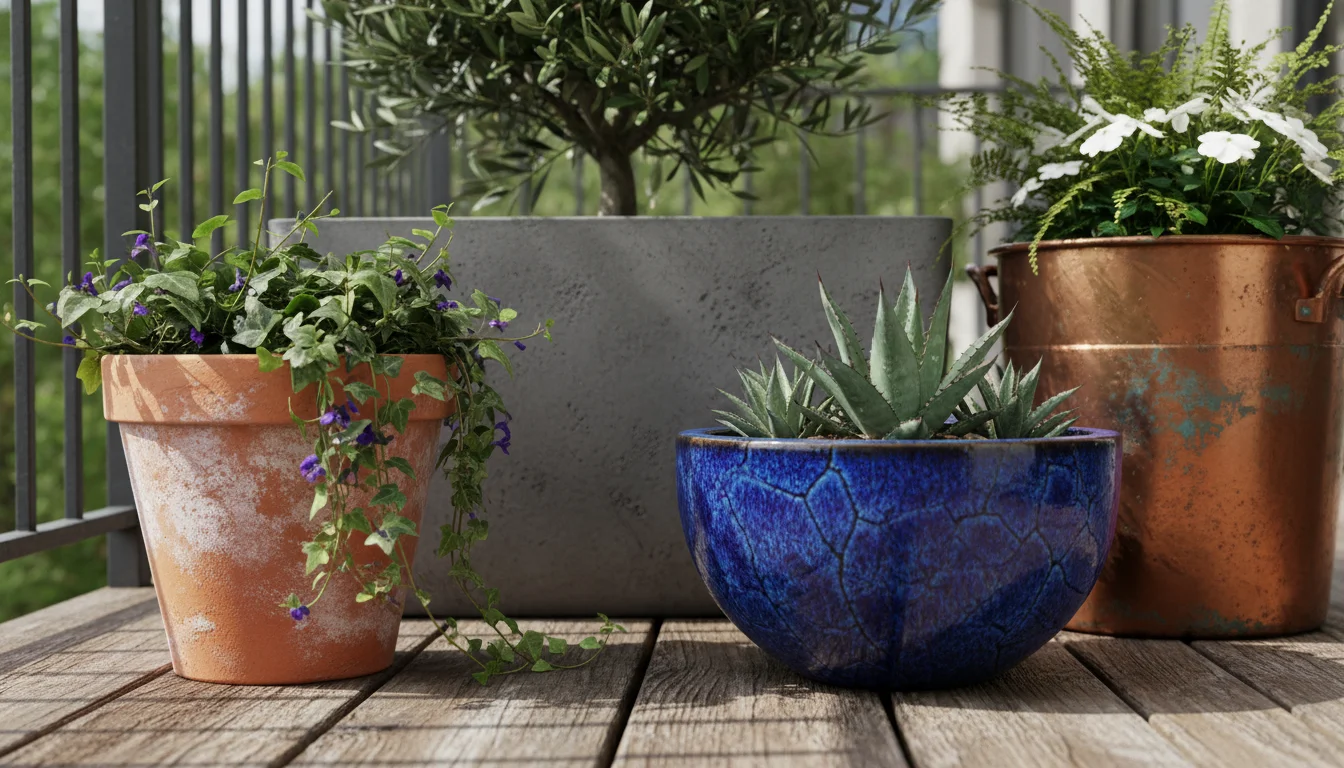
Material Matters for Your Aesthetic
The material of your containers dictates much of your balcony’s style. Consider:
- Terracotta: Classic, breathable, and rustic. Excellent for plants that prefer well-drained soil, but they dry out quickly. Unglazed terracotta can show salt deposits.
- Ceramic/Glazed Pottery: Elegant, vibrant, and retains moisture well. Heavier and can be expensive. Ensure they are frost-proof if left outside in cold climates.
- Lightweight Resin/Plastic: Affordable, durable, and excellent for moisture retention. Many modern designs mimic the look of terracotta, stone, or metal without the weight. They are ideal if weight is a concern for your balcony structure.
- Metal (Galvanized Steel, Copper): Modern, sleek, and industrial. Can heat up in direct sun, potentially stressing plant roots. Use lighter-colored metals or add insulation for best results.
- Wood (Cedar, Treated Pine): Natural, insulative, and integrates well with natural aesthetics. Requires liners to prevent rot and can be heavy.
Choose materials that complement your home’s exterior and your indoor decor, creating a seamless transition.
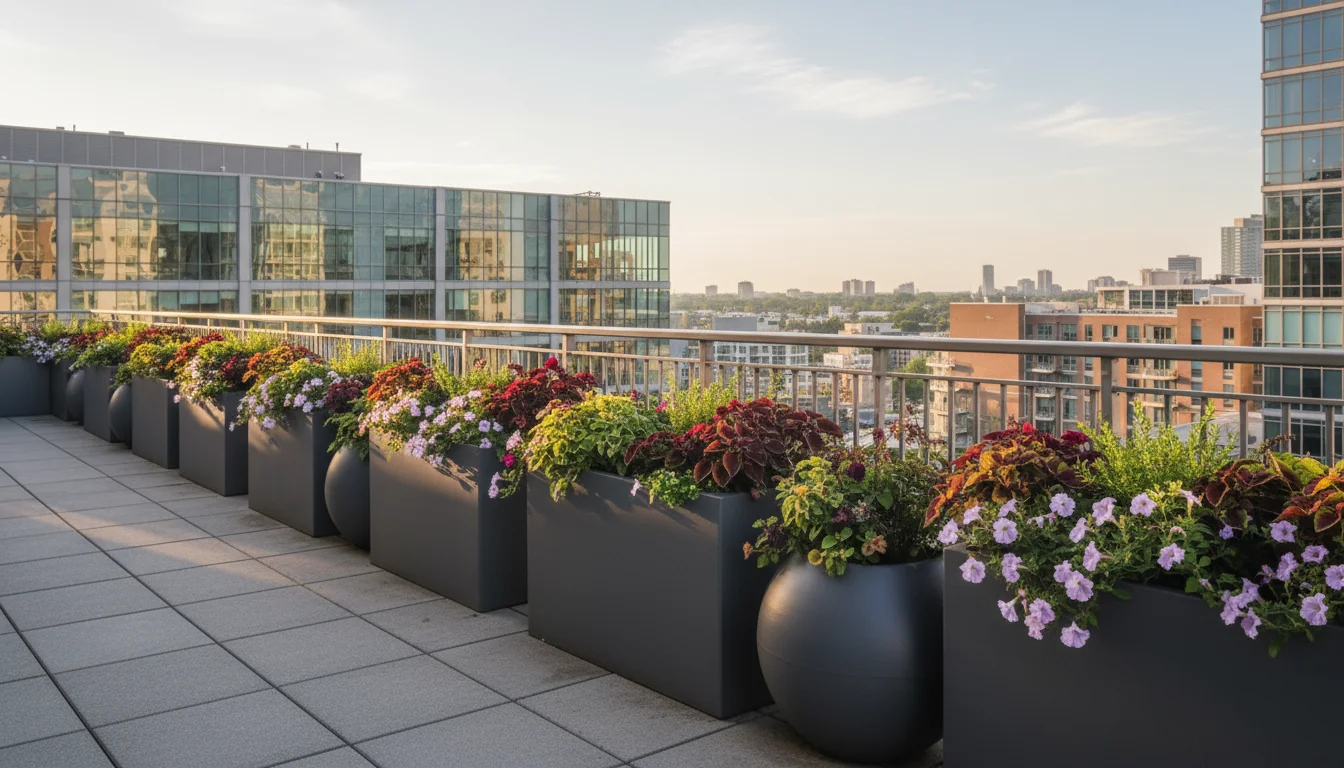
Color and Finish Cohesion
To achieve a unified and sophisticated look, select containers with a consistent color palette or finish. For example:
- All black or dark gray pots provide a contemporary, minimalist backdrop that allows the plants to shine.
- Varying shades of natural terracotta or stone offer an earthy, rustic feel.
- Matching brightly colored pots in a single hue (e.g., all blues or all yellows) create a bold, playful statement.
Avoid a chaotic mix of too many different container colors and styles. Limiting your palette creates visual harmony and makes the space feel more intentional and less haphazard.
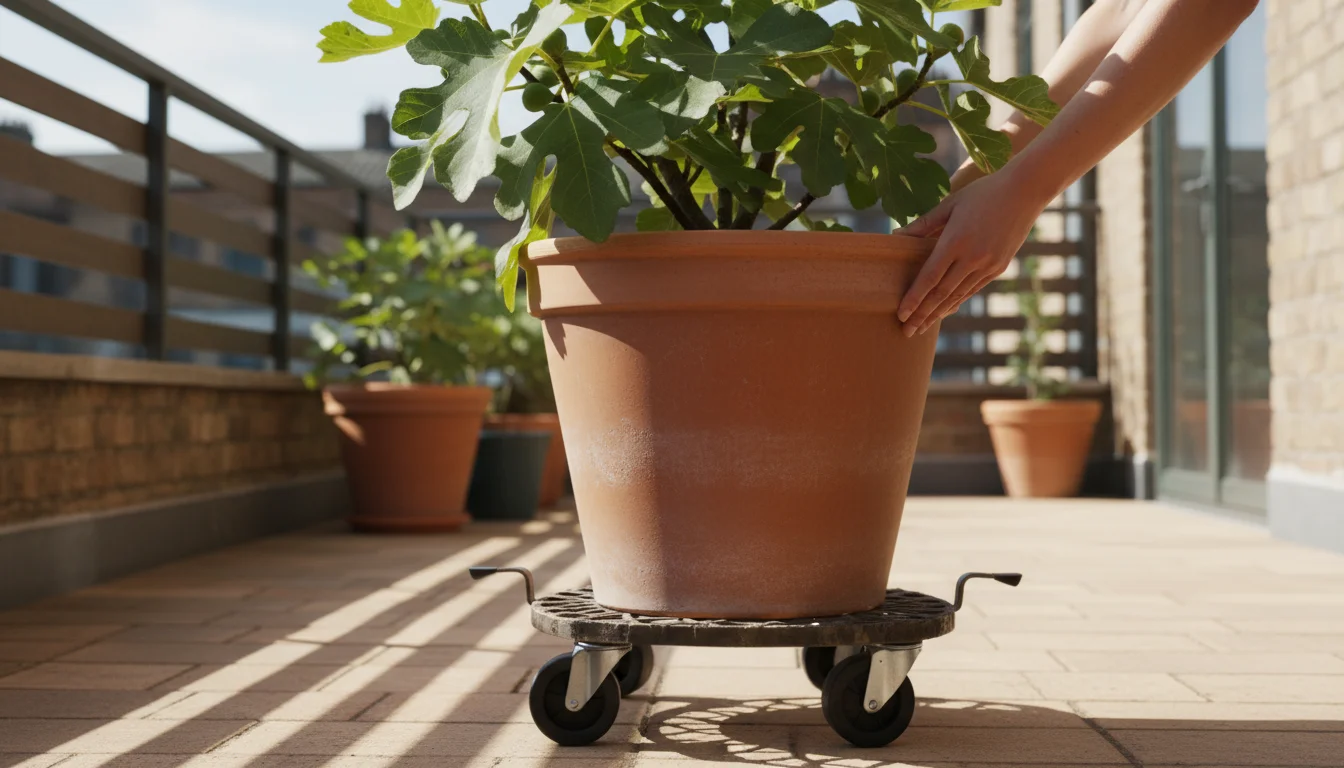
Wheeled Bases for Flexibility
For larger, heavier pots, invest in wheeled bases, also known as plant caddies. These simple additions offer immense flexibility:
- Easy repositioning: Move plants to optimize sun exposure, accommodate guests, or simply change your layout.
- Cleaning: Easily move pots to sweep or clean the balcony floor.
- Winter protection: Roll frost-sensitive plants indoors or to a more sheltered spot.
Ensure the wheeled bases are robust enough for the weight of your filled containers and have locking wheels for stability.
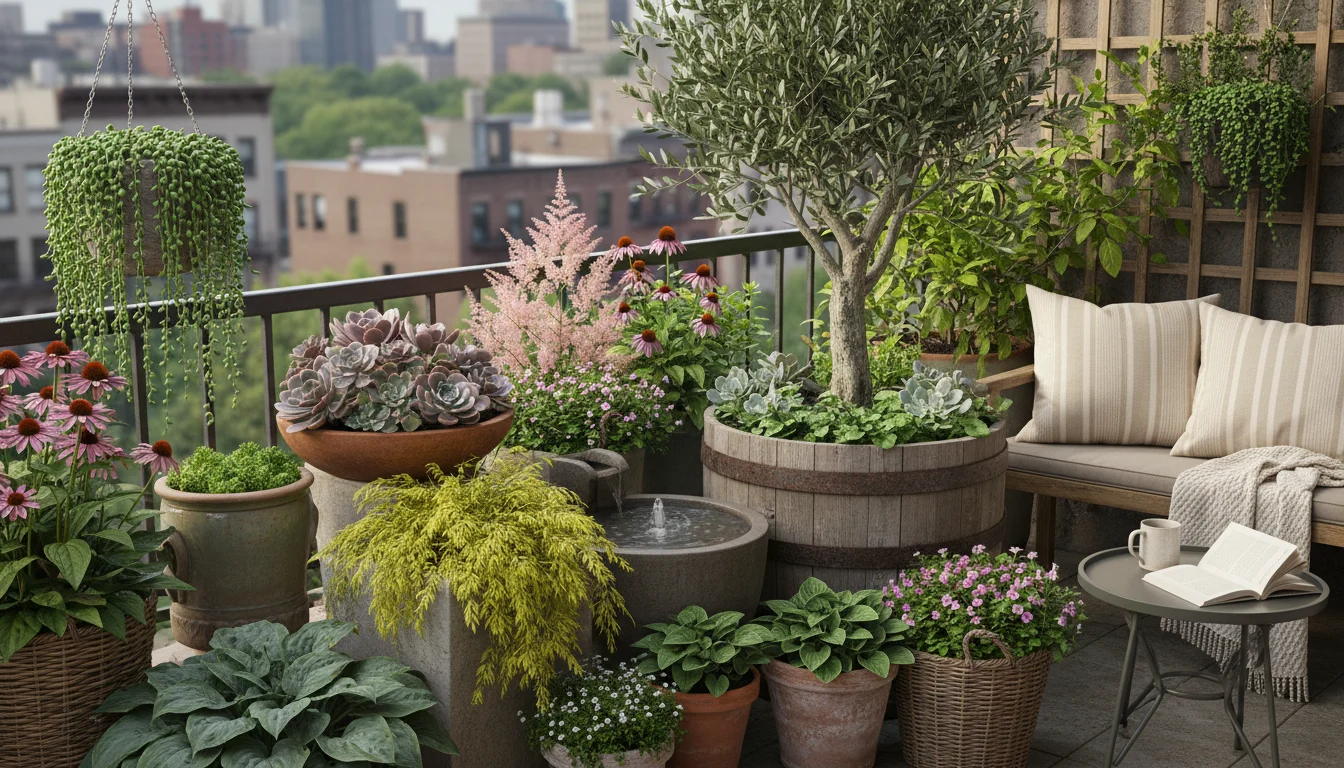
Color and Texture Palettes: Engaging the Senses
Just like an interior designer uses color and texture to create mood and interest, you can apply these principles to your balcony garden design. A well-considered palette prevents visual chaos and transforms your garden into a harmonious, sensory experience. The goal is to create continuity and visual intrigue without overwhelming a small space.
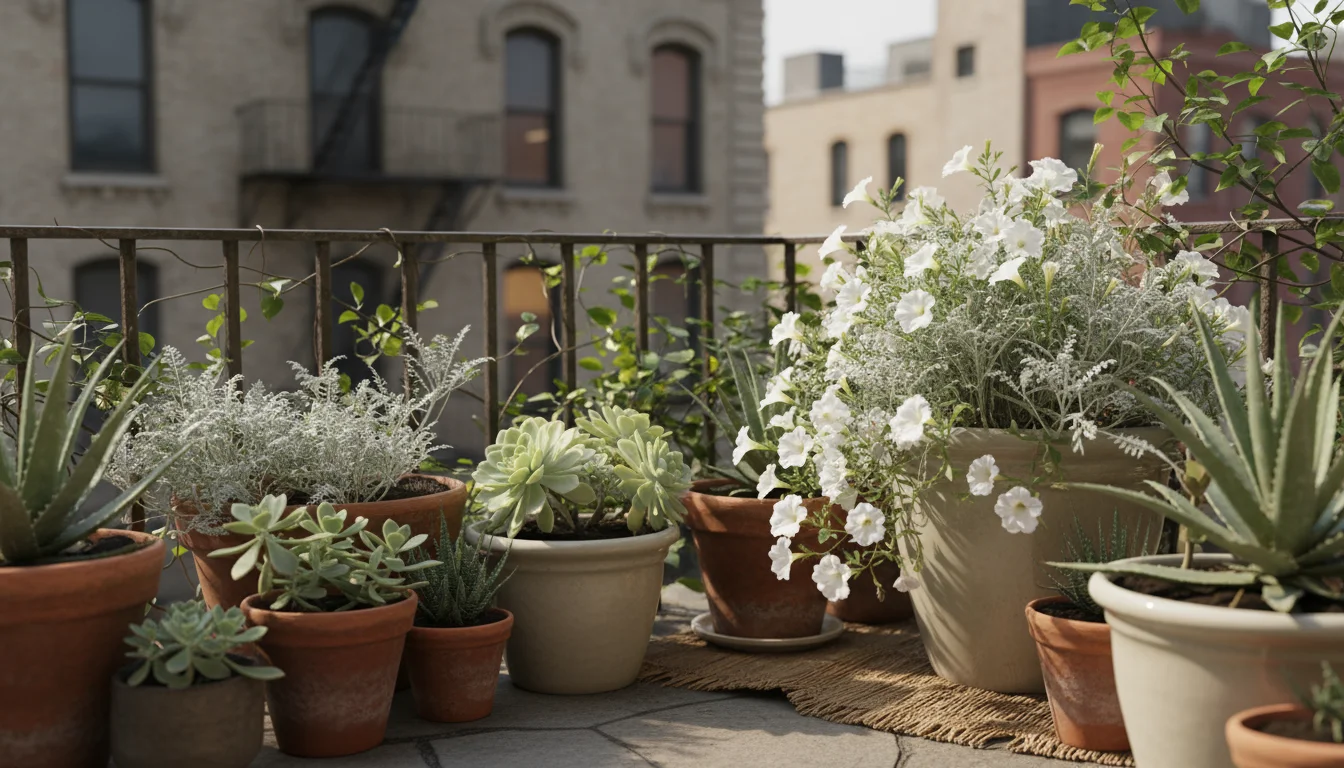
A Limited Color Palette for Harmony
In a compact area, restraint with color is key. Choose two to three primary colors for your flowers and foliage. This creates a cohesive look and allows individual plants to stand out without competing for attention. Consider:
- Monochromatic: Varying shades of a single color (e.g., different blues, purples, or whites) create a serene and sophisticated atmosphere.
- Analogous: Colors next to each other on the color wheel (e.g., yellows, oranges, and reds for a vibrant, warm feel; blues, purples, and greens for a calm, cool effect).
- Complementary accents: Use a complementary color (opposite on the color wheel, like blue and orange) sparingly for a pop of drama, rather than as a dominant theme.
White, silver, and pale pink flowers often create a sense of spaciousness and glow beautifully in evening light. Deep reds and purples can make a space feel more intimate and rich.
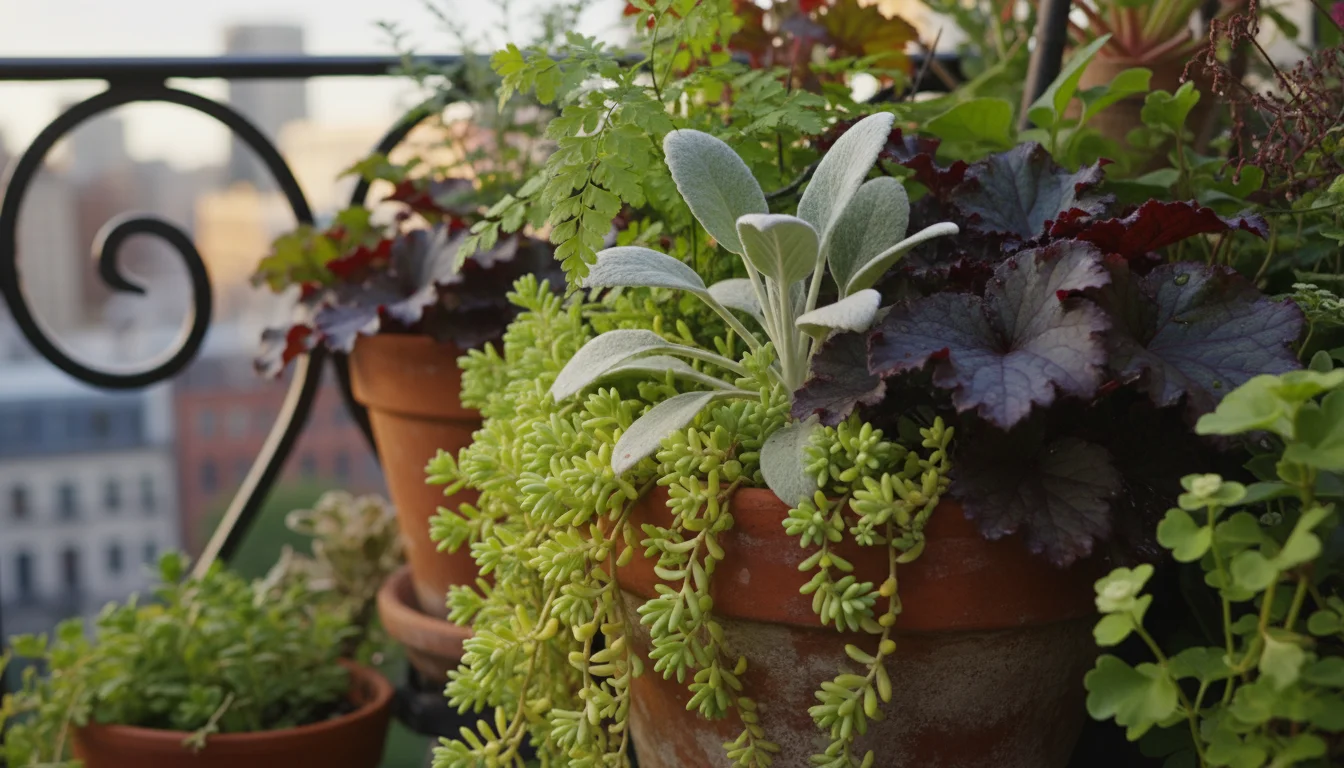
Foliage Contrast: Your Year-Round Interest
While flowers are beautiful, their blooms are often fleeting. Foliage, however, provides consistent texture and color throughout the growing season, and often into winter. Rely heavily on foliage to create lasting interest:
- Vary leaf shapes and sizes: Pair broad-leaved plants like hostas or caladiums with fine-textured ferns or grasses.
- Contrast colors: Combine plants with dark green, chartreuse, silver, variegated, or burgundy leaves. For example, a silvery ‘Lamb’s Ear’ (Stachys byzantina) next to a dark-leaved Heuchera creates stunning contrast.
- Look for interesting patterns: Striped, spotted, or variegated foliage adds depth without relying on blooms.
Foliage provides the enduring structure and beauty of your balcony garden, making it attractive even when flowers are not in bloom.
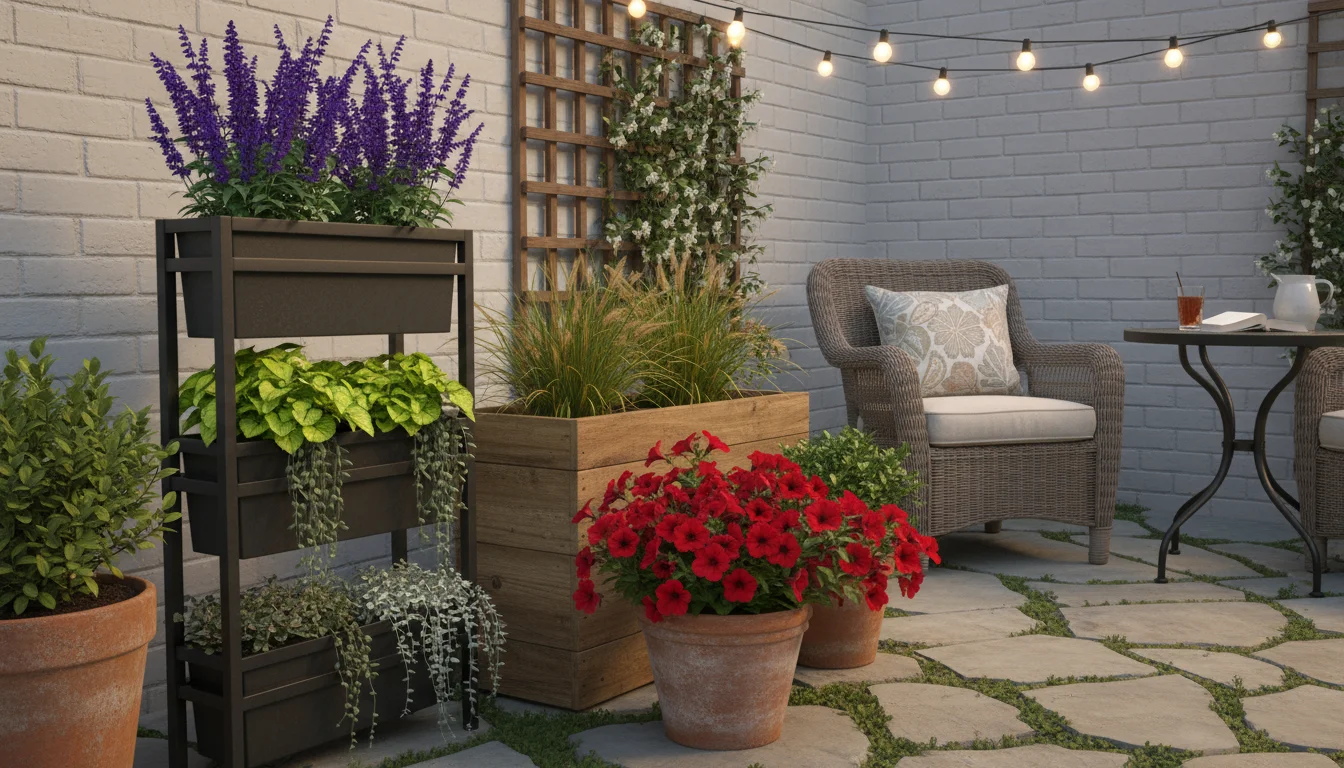
Seasonal Interest and Bloom Sequence
Plan for continuous interest by selecting plants with staggered bloom times or those that offer seasonal changes beyond just flowers. Consider:
- Early spring: Pansies, primroses, bulbs.
- Late spring/early summer: Petunias, calibrachoa, geraniums.
- Mid-summer: Salvias, coleus (for foliage), impatiens.
- Fall: Chrysanthemums, ornamental grasses, plants with colorful berries.
Some plants, like certain salvias or fuchsias, bloom for extended periods, providing consistent color. Others offer attractive seed heads or vibrant fall foliage, extending your garden’s appeal well into the cooler months. This ensures your outdoor room never looks empty or past its prime.
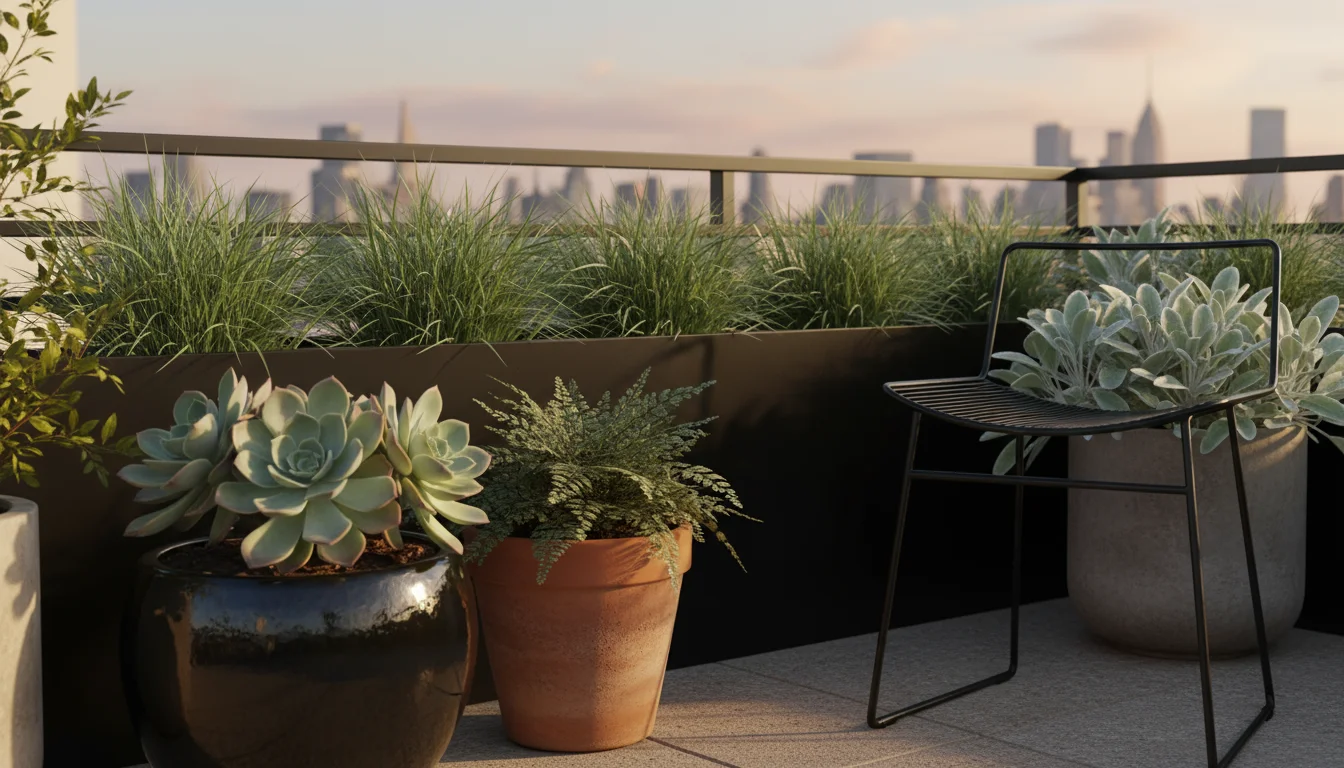
Textural Intrigue
Texture adds another layer of sensory engagement to your balcony garden. Contrast fine textures with coarse ones to create visual excitement:
- Fine textures: Delicate ferns, wispy grasses, tiny-leaved herbs. These create a light, airy feeling.
- Medium textures: Most common annuals and perennials.
- Coarse textures: Large-leaved plants like hostas, elephant ears, or succulents with thick, fleshy leaves. These create bold statements.
Do not forget the texture of your containers and furniture. A smooth, glazed pot next to a rough, porous terracotta pot, or a sleek metal chair contrasted with a fuzzy lamb’s ear plant, all contribute to the rich sensory experience of your outdoor room.
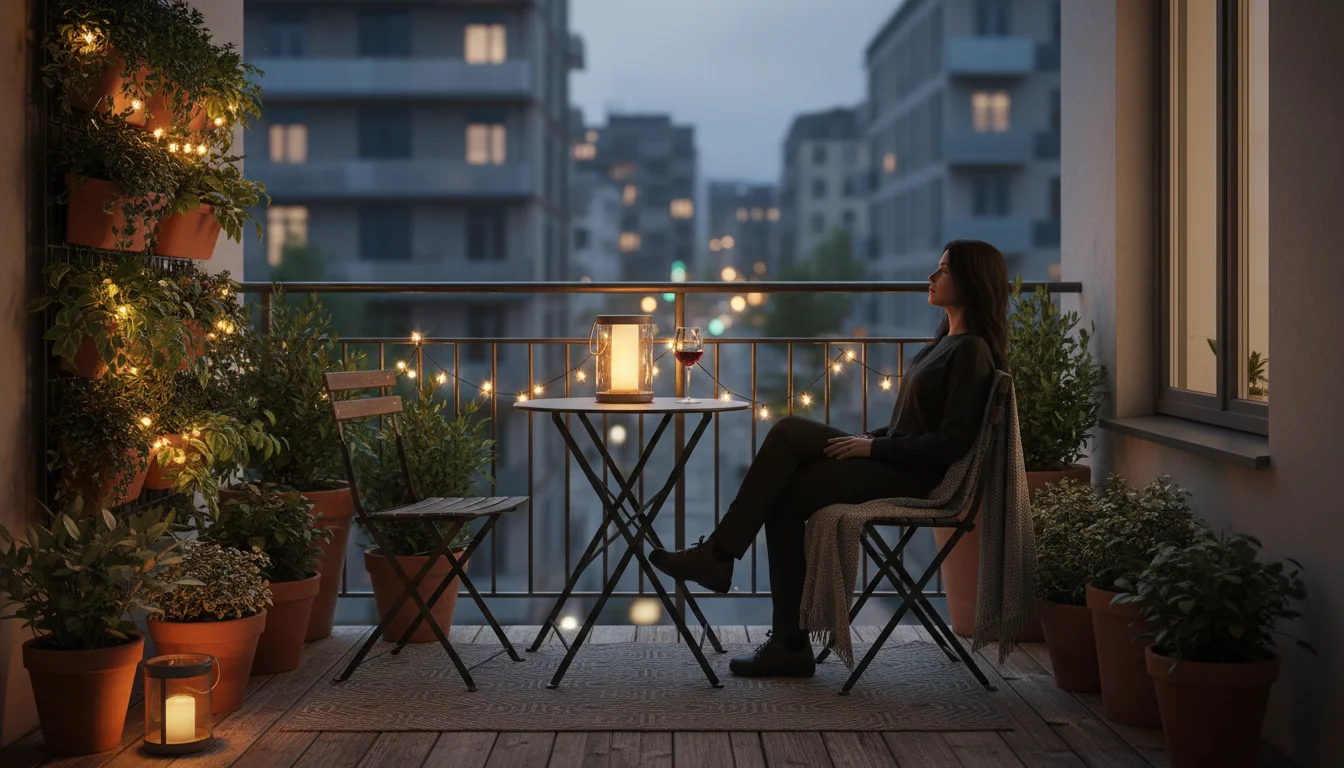
Lighting and Evening Ambiance: Extending Your Outdoor Hours
To truly feel like an outdoor room, your balcony must be inviting after sunset. Thoughtful lighting transforms the space, extends its usability into the evening hours, and creates a magical, intimate ambiance. Think about how you light your indoor rooms; apply similar principles to your balcony garden design.
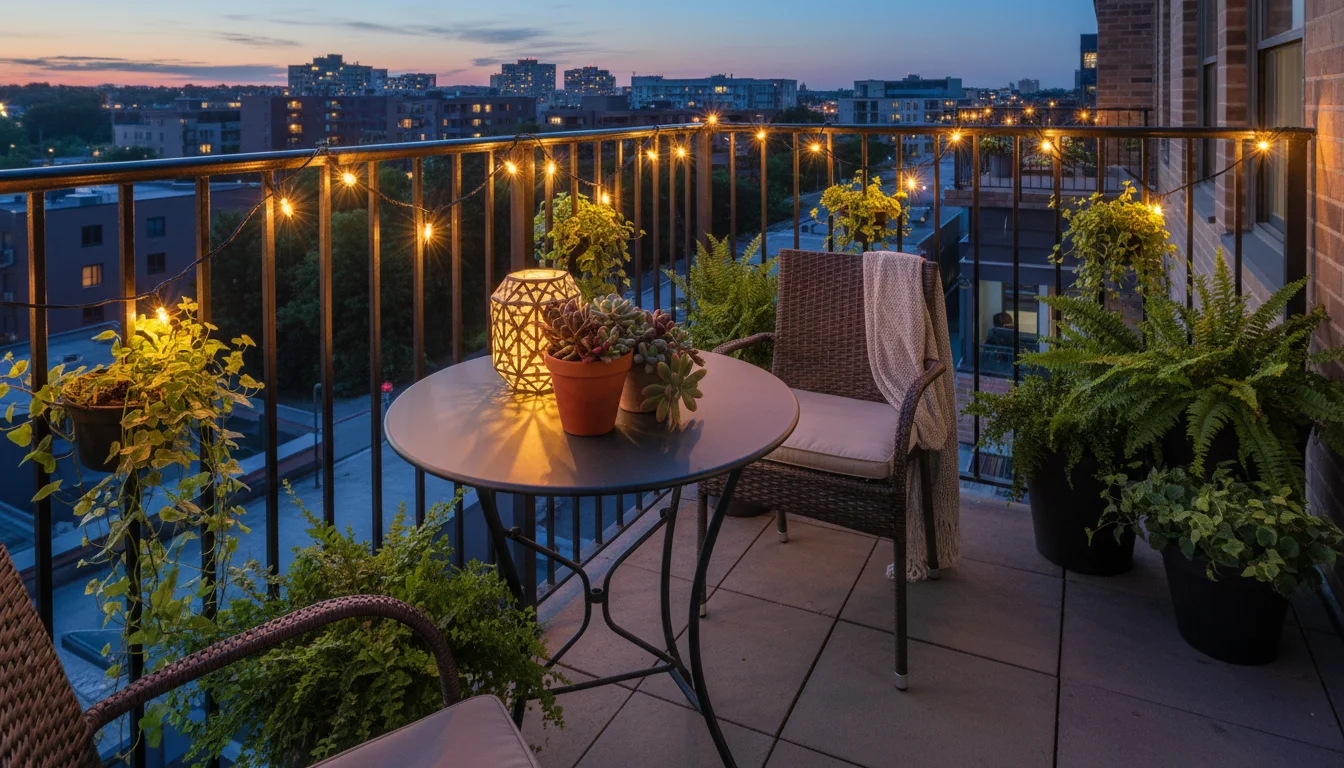
Creating Mood with Ambient Lighting
Ambient lighting forms the foundation of your evening atmosphere. It provides a general glow without being harsh. Consider:
- String Lights: Often called “fairy lights” or bistro lights, these are perhaps the most popular choice. Drape them along railings, weave them through trellises, or crisscross them overhead. They cast a warm, inviting glow that instantly signals “cozy outdoor room.” Look for solar-powered options for ease of installation or low-voltage LED strings for energy efficiency.
- Solar Lanterns and Stakes: Place solar-powered lanterns on tables or hang them from hooks. Solar stakes can illuminate pathways or highlight specific plants. These charge during the day and automatically turn on at dusk, providing effortless illumination.
- LED Strip Lights: For a more modern, subtle effect, adhere LED strips under railings, along the base of planters, or beneath seating. They offer a continuous, soft light that defines the edges of your space.
Use warm white light (around 2700K) for a cozy, inviting feel, rather than bright, cool white light, which can feel harsh and clinical.
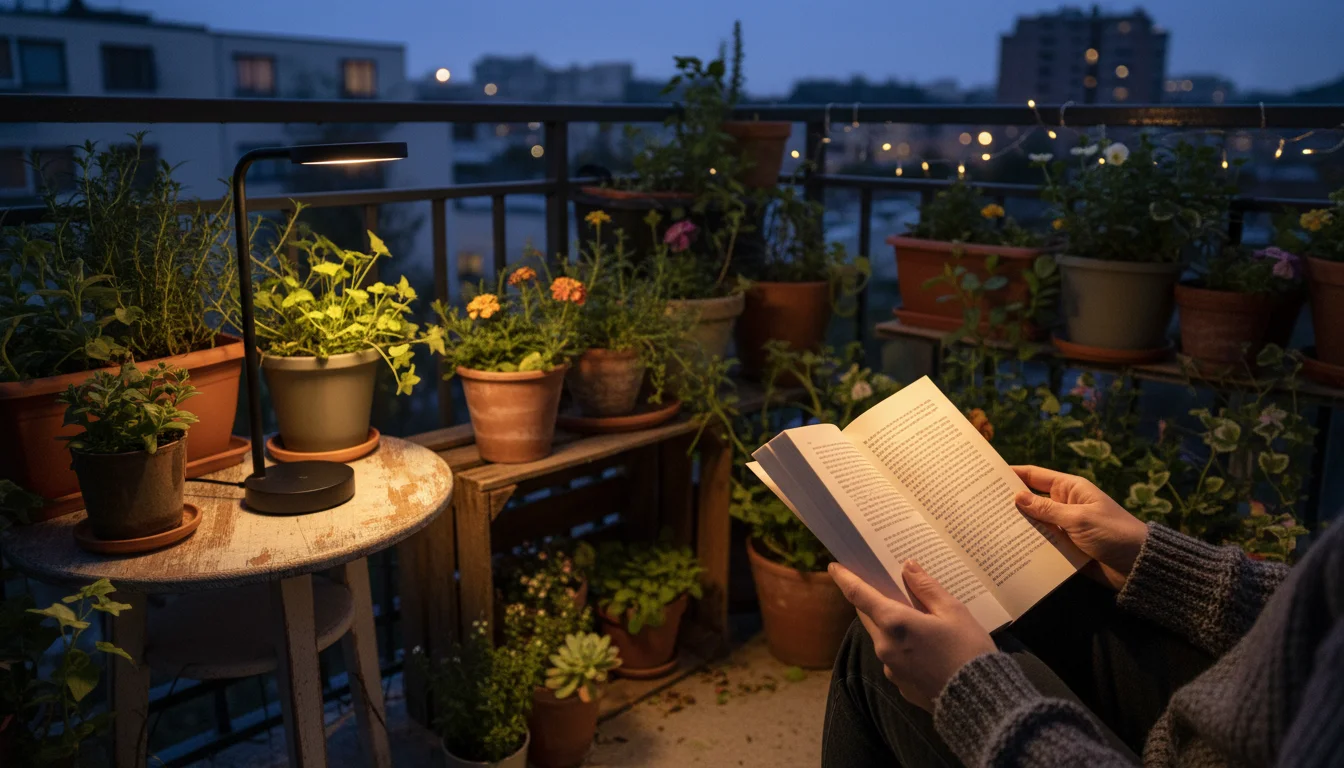
Incorporating Task Lighting for Functionality
If you plan to read, dine, or engage in other activities on your balcony after dark, you will need more focused task lighting. This complements your ambient lighting without overpowering it.
- Battery-Operated Lamps: Portable lamps designed for outdoor use can be placed on a side table for reading or on a dining table for meals. Choose rechargeable models for sustainability.
- Wall Sconces: If your balcony has an outdoor electrical outlet and allows for permanent fixtures, small outdoor wall sconces can provide directed light.
Position task lights strategically so they illuminate your activity area without creating harsh shadows or glare.
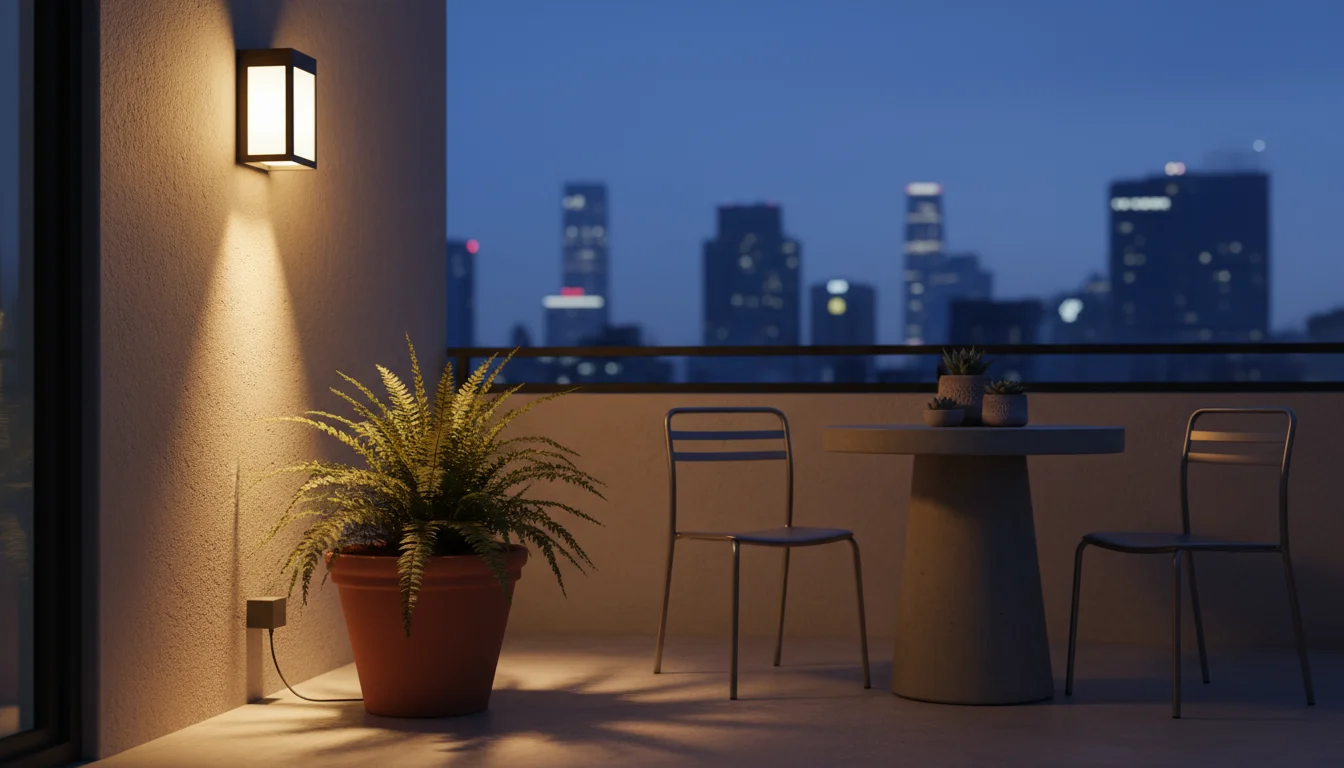
Controlling Glare for Comfort and Courtesy
Glare detracts from comfort and can disturb neighbors. Position all lights carefully to avoid shining directly into your eyes, adjacent windows, or neighboring balconies. Uplighting plants from below or directing lights downwards creates a softer effect. Use shades or diffusers on brighter light sources if needed. The goal is a gentle, inviting glow, not a spotlight.
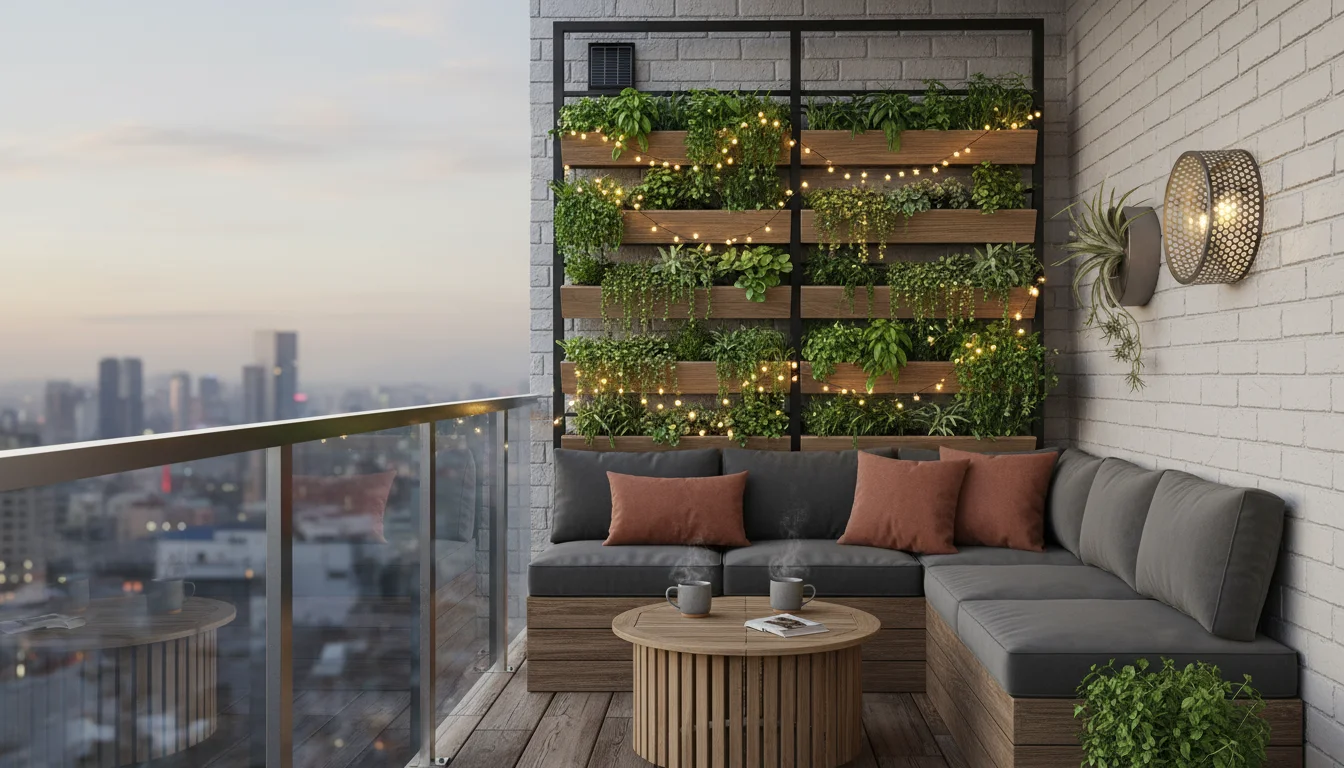
Prioritizing Safety and Sustainability
- Outdoor-Rated Fixtures: Always ensure any electrical lighting fixtures or extension cords you use are rated for outdoor use and damp conditions. Look for IP (Ingress Protection) ratings appropriate for outdoor environments (e.g., IP44 or higher).
- Low-Voltage Options: Solar and battery-operated lights are the safest and easiest to install, requiring no complex wiring. If using mains power, opt for low-voltage systems where possible, as they reduce electrical hazards.
- LED Technology: LEDs are energy-efficient, long-lasting, and generate minimal heat, making them a sustainable choice for your balcony lighting.
- Weight Limits: Be mindful of any weight limits for hanging lights, especially if draping heavy strings across a wide span.
By thoughtfully layering ambient and task lighting, you transform your balcony into a functional, inviting outdoor room that extends your enjoyment well into the evening hours.
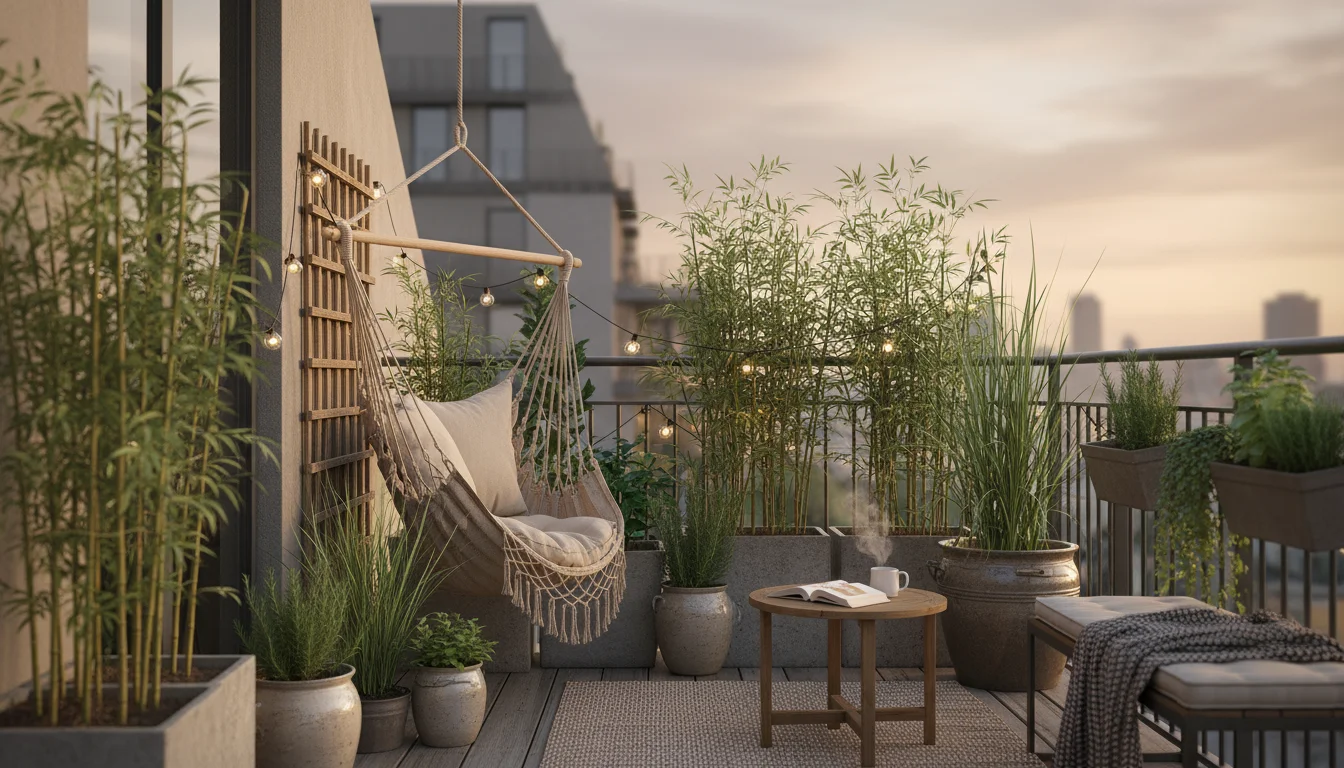
Privacy and Screening: Creating Your Secluded Retreat
A true outdoor room provides a sense of enclosure and intimacy. If your balcony is exposed to neighbors, street views, or strong winds, privacy and screening become essential design elements. These additions define your boundaries and create a secluded, comfortable retreat, making you feel truly at home in your balcony garden.
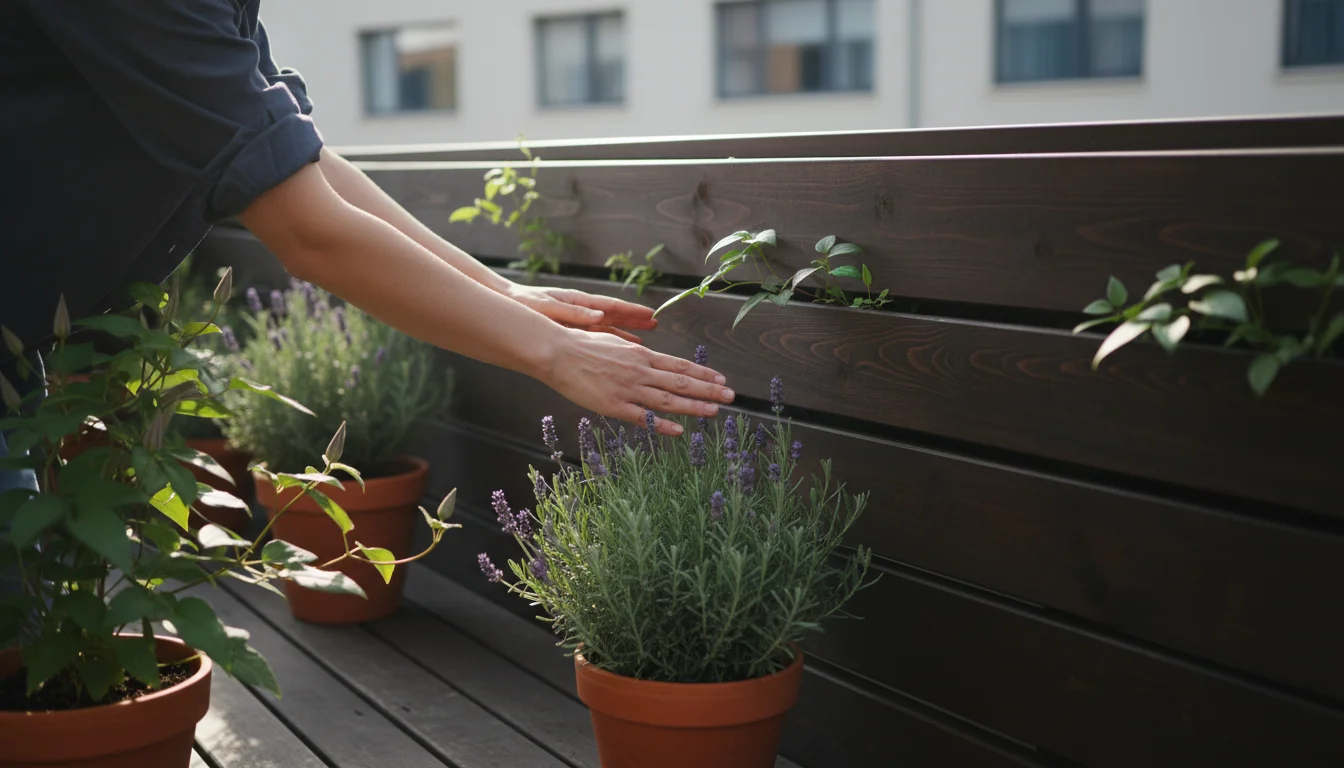
Defining Your Personal Boundaries
The first step is to identify where you need privacy most. Is it from direct sightlines of neighbors, a busy street, or simply to create a more enclosed feeling? Your chosen screening method should address these specific needs while enhancing the aesthetic.
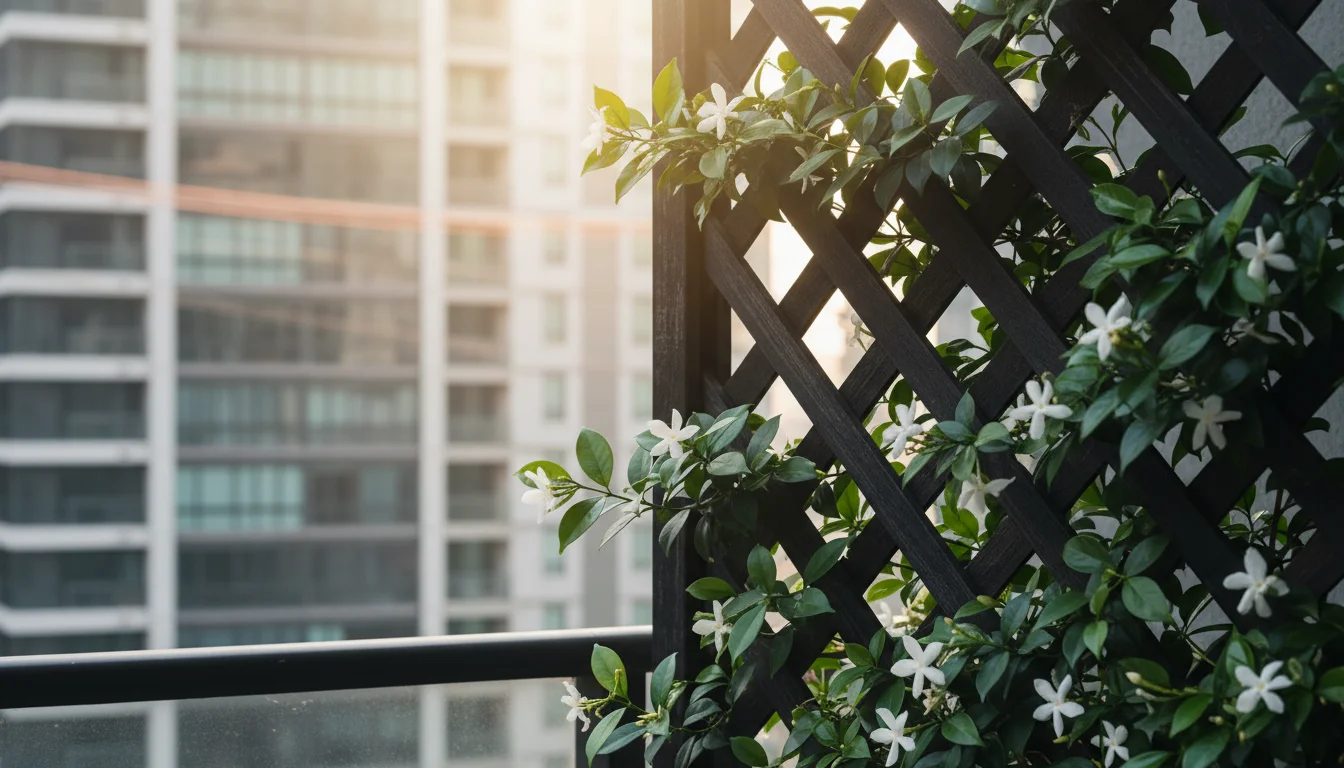
Living Screens with Lattice and Trellis
Living screens are both beautiful and environmentally friendly. They soften hard architectural lines and absorb some sound.
- Lattice Panels: Install wooden or PVC lattice panels along railings or walls. These provide immediate partial screening and act as a support structure for climbing plants. Choose weather-resistant materials.
- Trellises with Climbers: Mount trellises and train vigorous climbing plants to grow over them. Excellent choices include star jasmine (fragrant and evergreen in many climates), clematis (beautiful flowers), or edible options like pole beans or passionfruit. Check with your landlord or building management about attaching structures to your balcony.
A living screen evolves with the seasons, offering dynamic interest throughout the year.
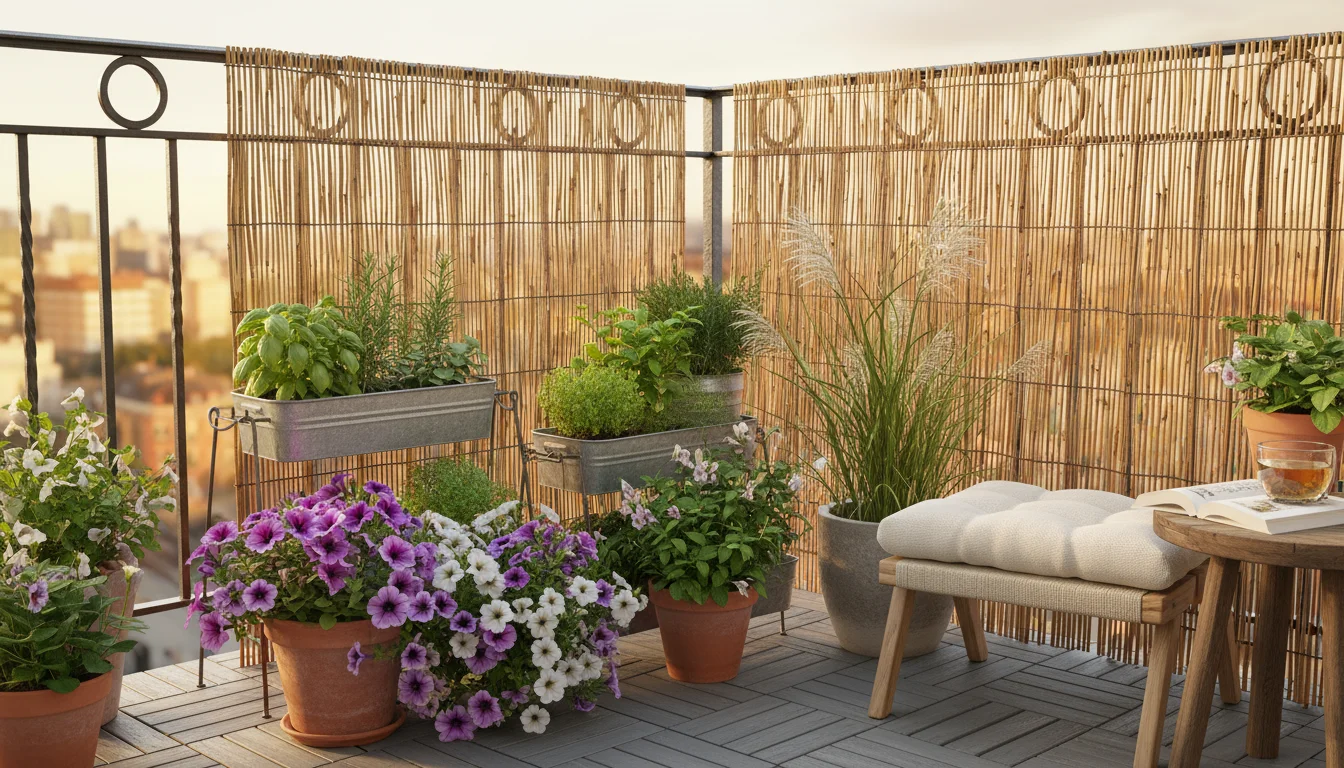
Instant Screening with Bamboo Frames and Panels
For quick and often removable privacy, consider:
- Bamboo Screens: Rolls of natural bamboo fencing can be tied to railings or attached to a simple frame. They offer a rustic, tropical feel and provide effective, immediate screening.
- Wood or Composite Panels: Freestanding or attachable panels made from wood or composite materials offer more solid privacy. These can be custom-built or purchased pre-made. They come in various designs, from slatted to decorative.
These options are particularly good if you cannot permanently alter your building’s structure.
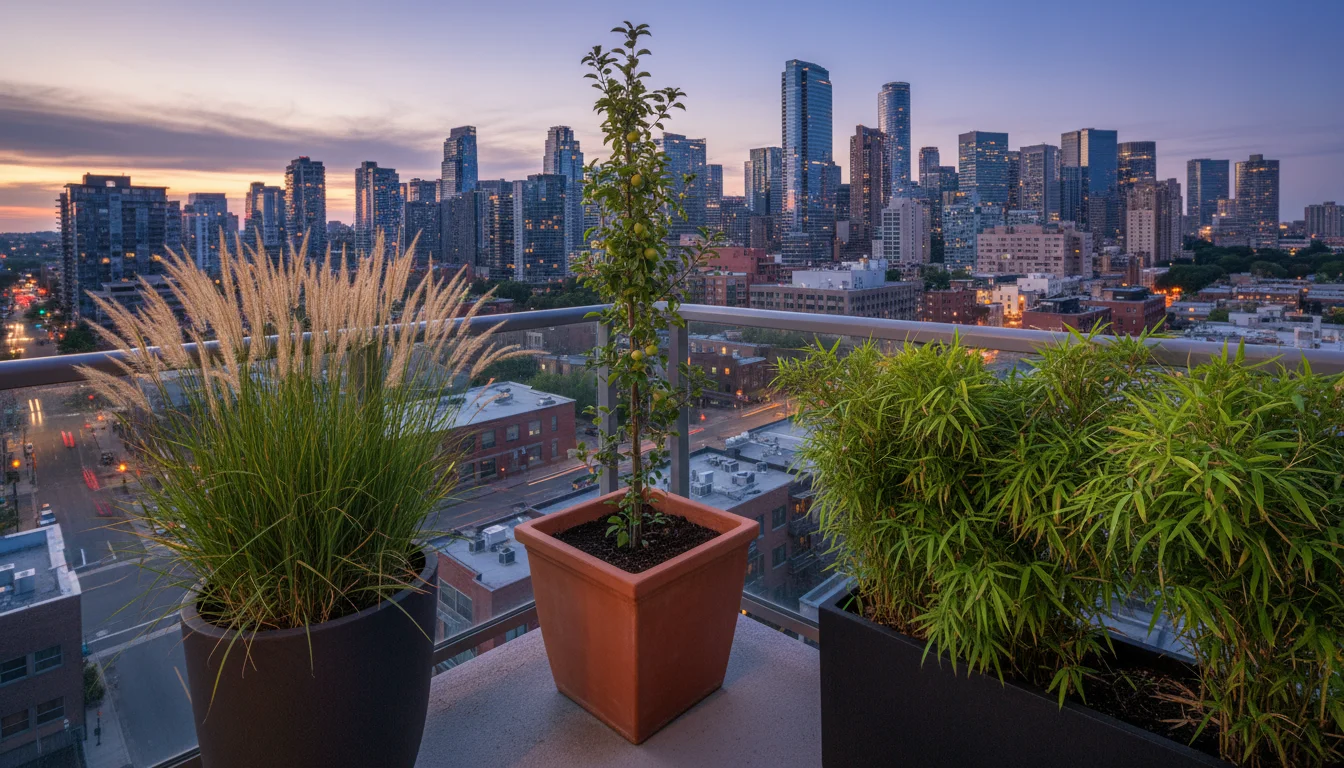
Tall Planters with Upright Plants: Strategic Placement
Strategic placement of tall planters filled with upright plants creates effective, flexible screening. This method allows you to move your screens as needed.
- Dense Shrubs or Ornamental Grasses: Choose plants like dwarf bamboo (clumping varieties, not running), columnar conifers, or tall ornamental grasses (e.g., Karl Foerster feather reed grass) that grow vertically with dense foliage.
- Fruiting Plants: Dwarf fruit trees like columnar apples or citrus can provide both screening and edibles.
- Placement: Position these large planters along exposed edges or in areas where you need to block a specific sightline. Ensure the containers are heavy and stable enough to prevent tipping, especially in windy conditions.
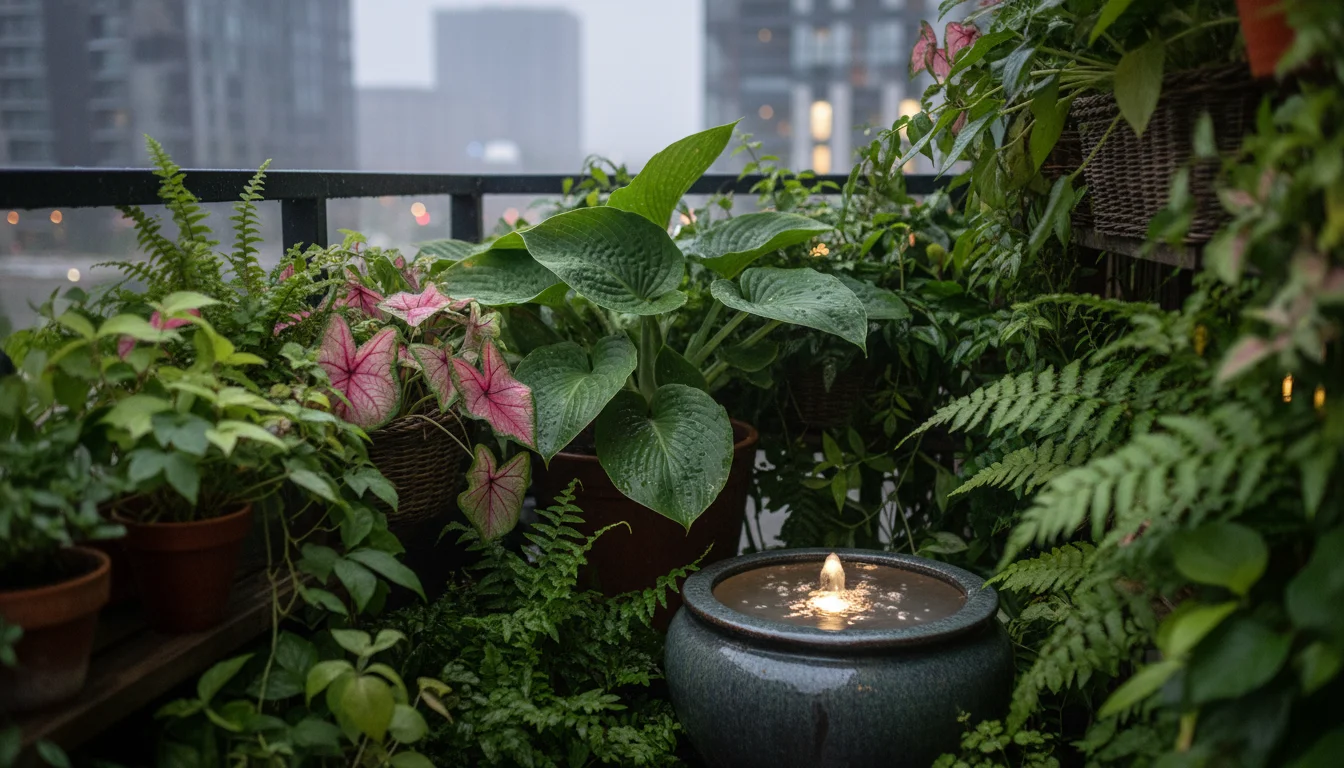
Softening Sound with Plants and Water Features
While physical screens block sight, plants also help absorb some ambient noise from a busy street or neighbors. Densely planted areas, especially those with larger, softer leaves, contribute to a quieter environment. For additional sound softening, consider a small, recirculating water feature. The gentle sound of trickling water can mask unwanted noise, creating a more peaceful and secluded atmosphere.
Always check your building’s rules and regulations regarding modifications to your balcony, attachment of screens, and weight limits before installing any permanent or large screening solutions.
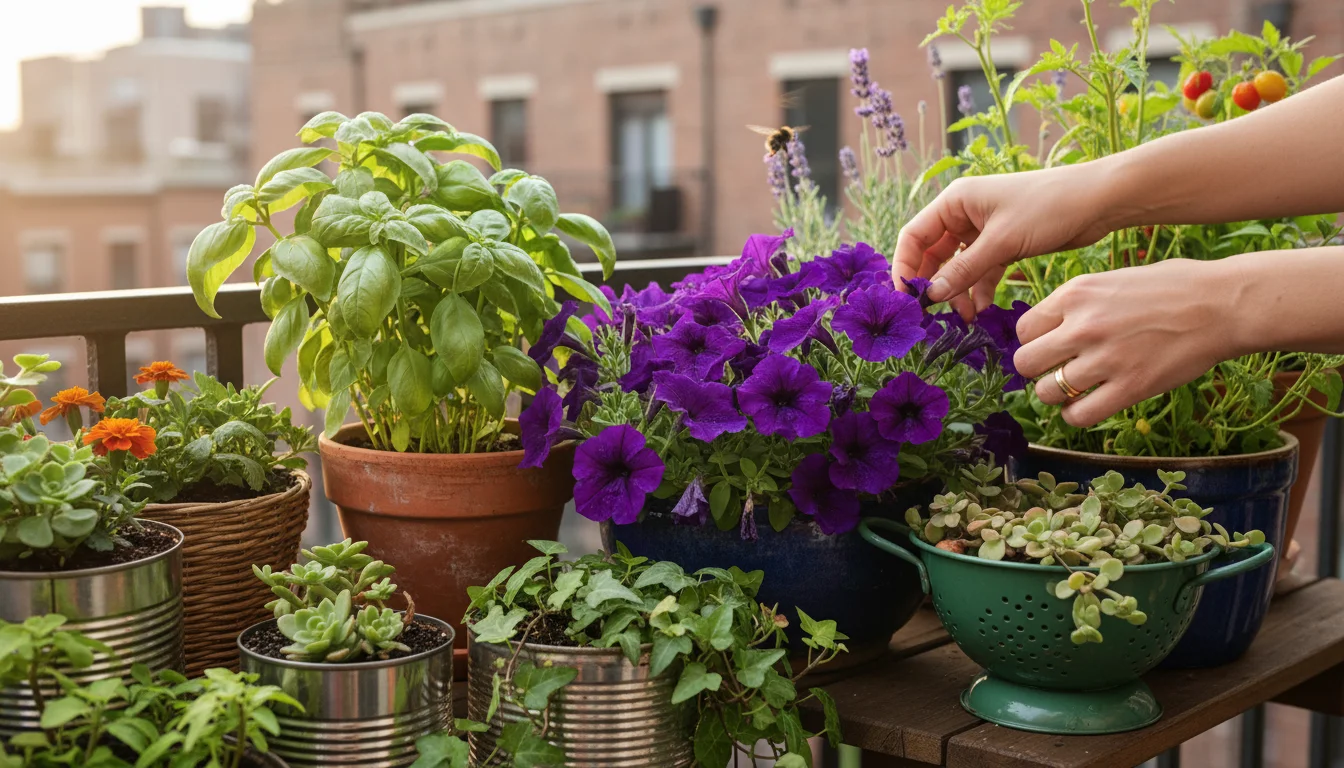
Planting Concepts for Impact and Sustainability
The plants you choose breathe life into your balcony garden, transforming it into a vibrant outdoor room. Selecting plants strategically, with an eye toward both aesthetic impact and environmental responsibility, ensures your garden thrives and provides continuous joy. Focus on sustainable practices that benefit both your garden and the planet.
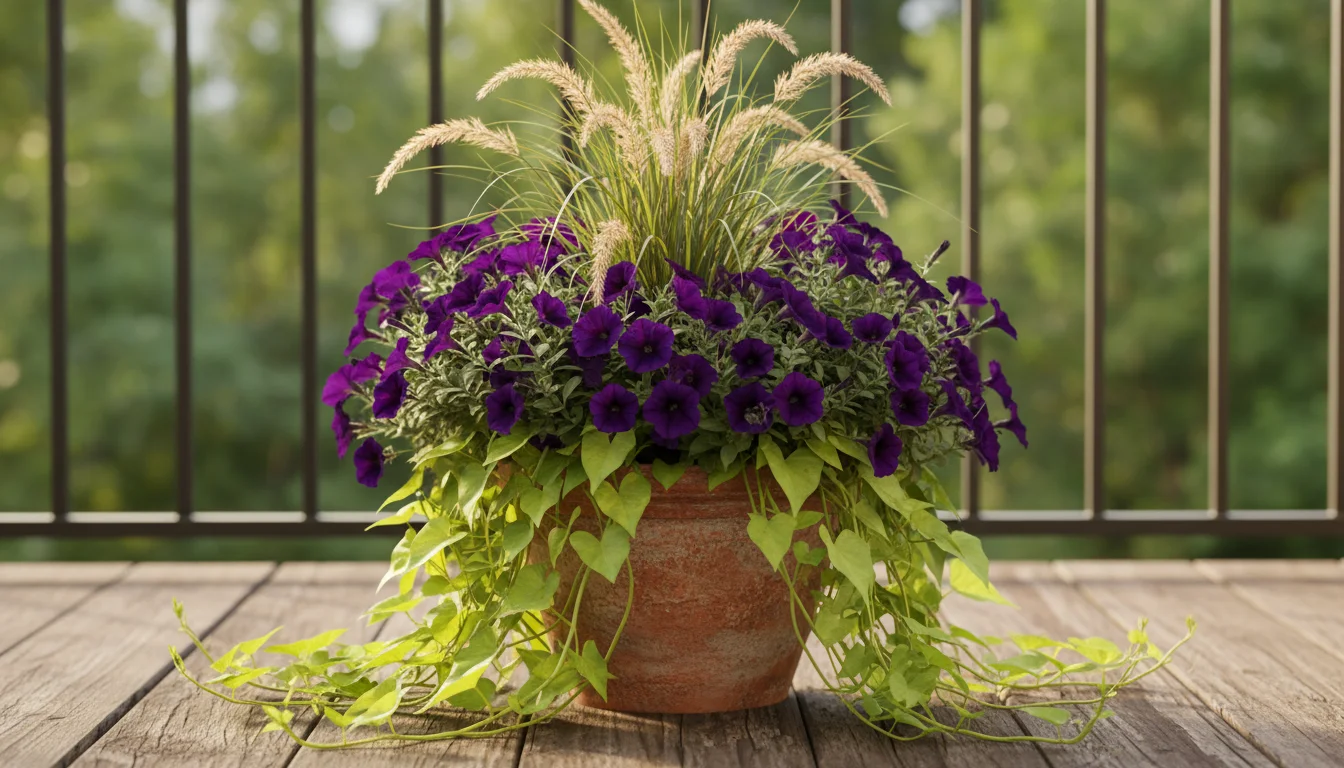
The Thriller-Filler-Spiller Method for Stunning Containers
This classic container design principle creates dynamic, full, and visually appealing arrangements. Each element plays a distinct role:
- Thriller: This is your vertical focal point, a tall, dramatic plant that draws the eye upward. Choose something with striking foliage or vibrant blooms. Examples include ornamental grasses, cannas, upright fuchsias, or a dwarf citrus tree. Place the thriller in the center of a pot viewed from all sides, or at the back if viewed against a wall.
- Filler: These are mounding or bushy plants that fill out the middle of the container, providing volume and cohesion. They typically grow to about two-thirds the height of the thriller. Good choices include impatiens, petunias, coleus, or herbs like basil or thyme. Use several filler plants around the thriller to create a full look.
- Spiller: These are trailing plants that cascade over the edges of the pot, softening hard lines and adding a luxurious, overflowing effect. Examples include sweet potato vine, calibrachoa, lobelia, or creeping jenny. Position spillers near the edges of the container so they can drape downwards.
By combining these three elements, you create a complete and captivating mini-ecosystem within each pot, providing visual depth and continuous interest. The Missouri Botanical Garden offers extensive plant search tools to help you find suitable thrillers, fillers, and spillers for your climate. For more information, visit Missouri Botanical Garden.
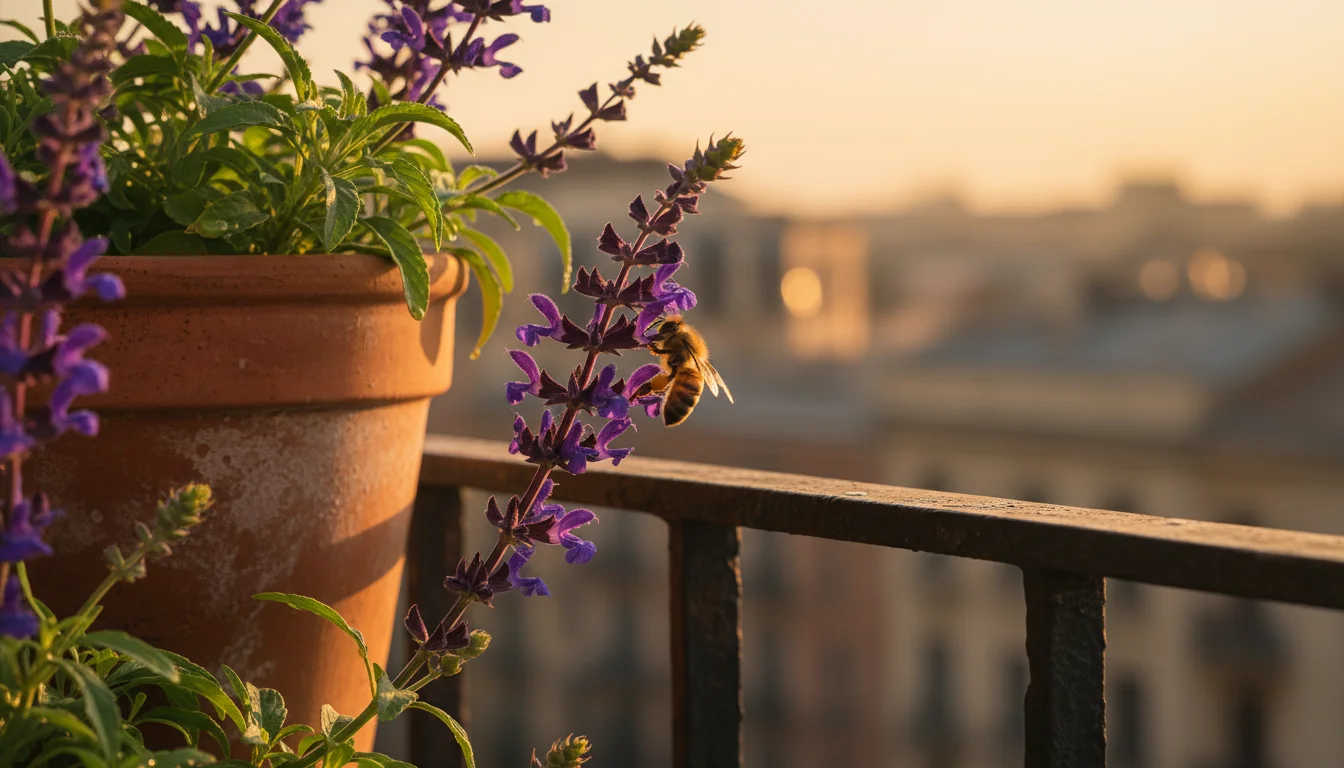
Embracing Native and Pollinator-Friendly Plants
Beyond aesthetics, your plant choices can contribute positively to your local ecosystem, even in a small balcony garden. Incorporating native and pollinator-friendly plants offers numerous benefits:
- Support Local Ecosystems: Native plants provide food and habitat for local birds, bees, butterflies, and other beneficial insects.
- Easier Maintenance: Native plants are naturally adapted to your local climate and soil conditions, often requiring less water, fertilizer, and pest control once established.
- Pollinator Haven: Balcony gardens can serve as crucial stepping stones for pollinators in urban environments. Choose flowering plants that attract bees and butterflies, such as salvias, coneflowers, or lavender.
Consult your local extension service or a native plant society for a list of plants indigenous to your region that thrive in containers. Resources like the Royal Horticultural Society also provide valuable guidance on pollinator-friendly gardening; explore their recommendations at Royal Horticultural Society (RHS).
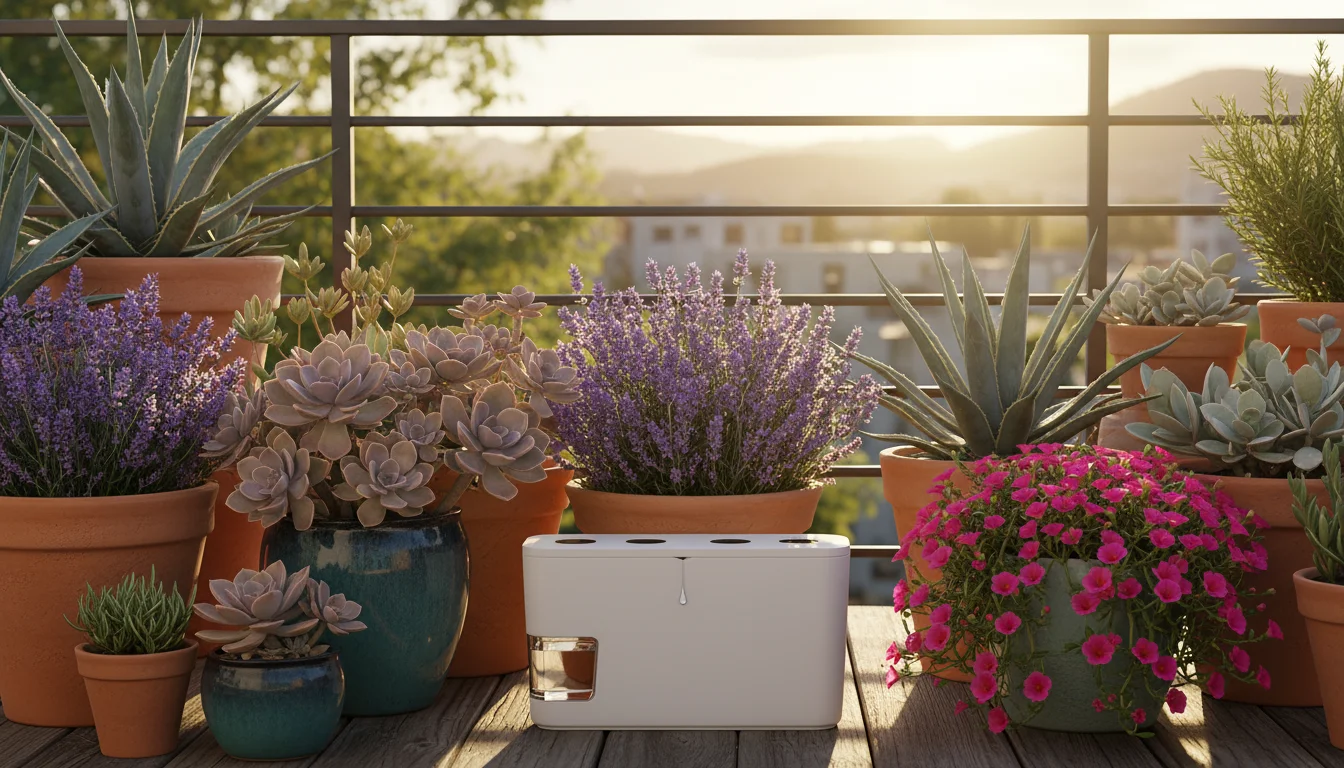
Water-Wise Choices: Sustainable Watering
Water conservation is vital, especially in container gardening where pots can dry out quickly. Select drought-tolerant plants that thrive with less water:
- Succulents and Cacti: A vast array of shapes, sizes, and colors that require minimal watering.
- Mediterranean Herbs: Lavender, rosemary, thyme, and oregano are beautiful, fragrant, and tolerant of dry conditions.
- Many Annuals and Perennials: Look for plants labeled as drought-tolerant, such as portulaca, verbena, gaillardia, or sedum.
Using self-watering planters or incorporating water-retentive crystals into your potting mix also helps reduce watering frequency. Grouping plants with similar water needs together simplifies your care routine.
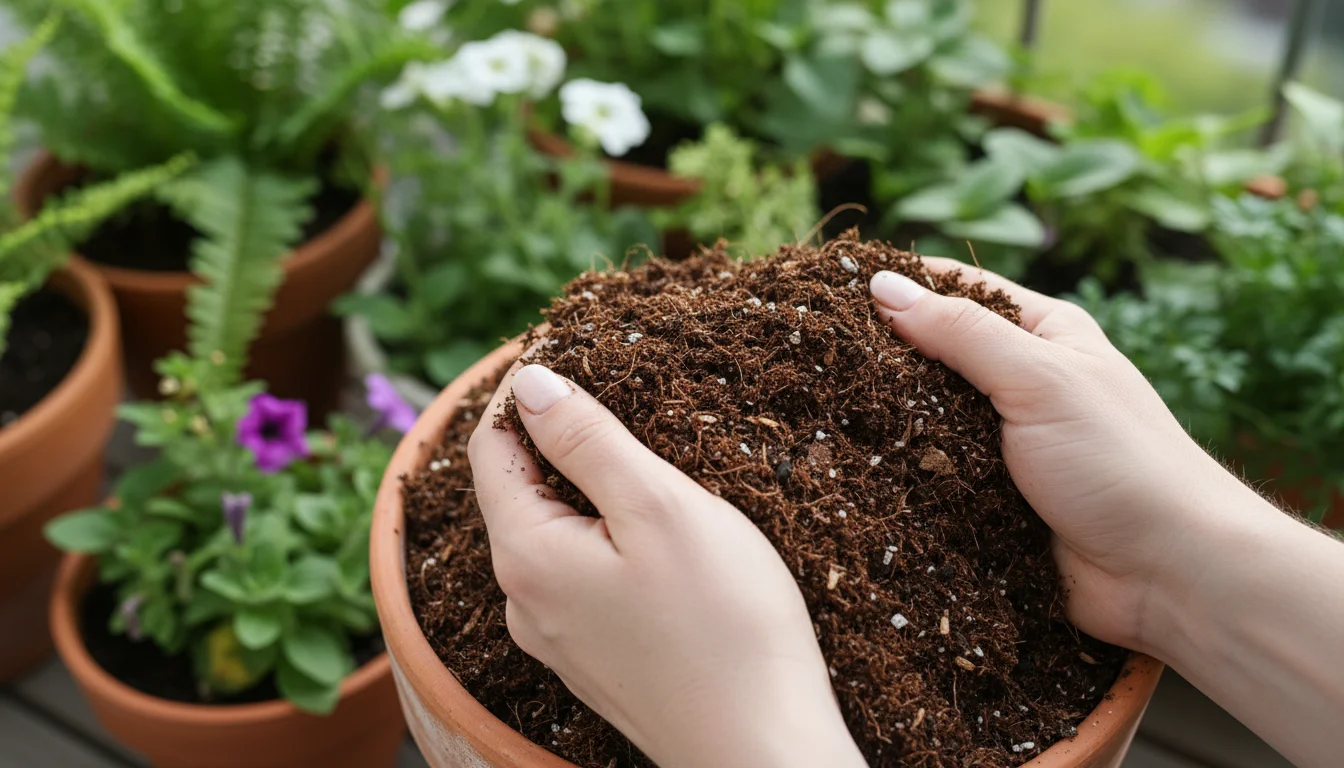
Prioritizing Peat-Free Potting Mixes
Choose peat-free potting mixes for environmental reasons. Peat harvesting damages peatlands, which are vital carbon sinks and delicate ecosystems. Modern peat-free alternatives, often made from coir, compost, and wood fiber, perform just as well, if not better, for container plants. They offer excellent drainage and aeration, supporting healthy root development. Selecting peat-free options aligns your gardening practices with broader sustainability goals.
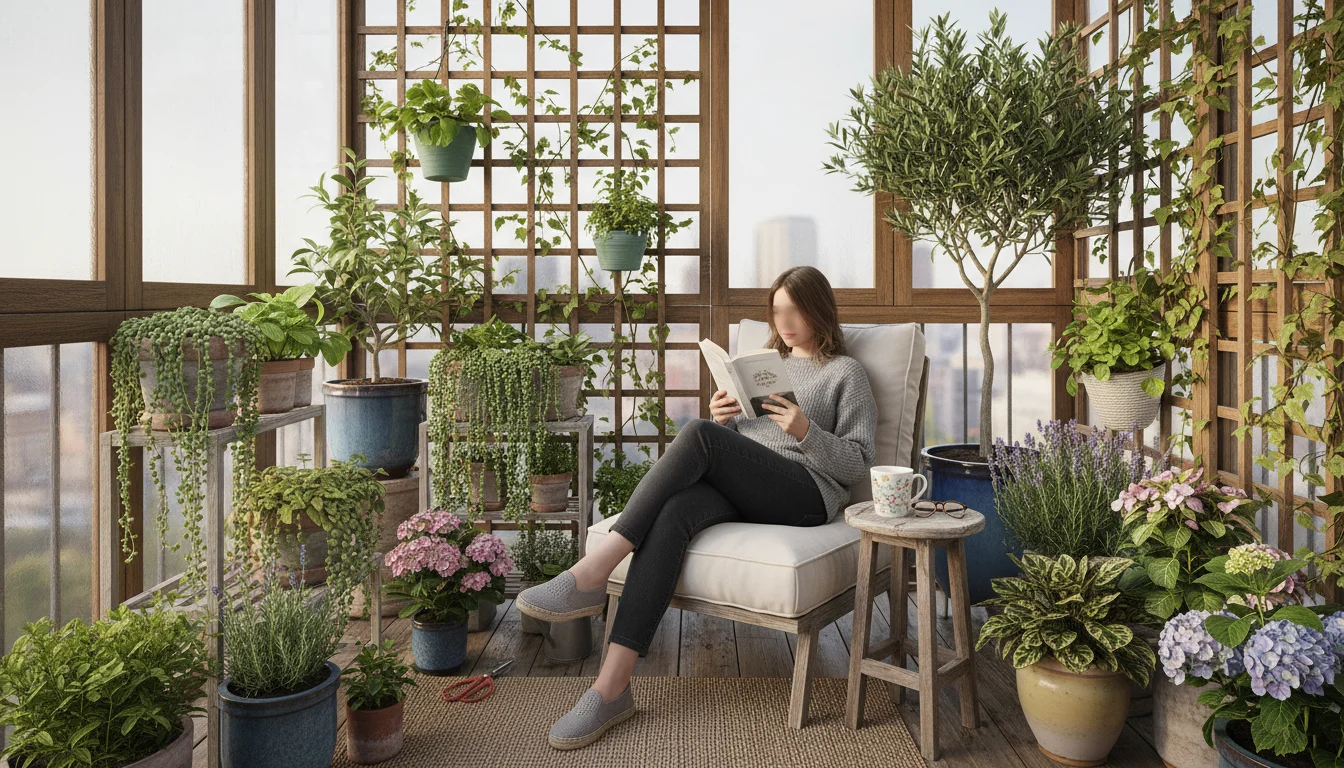
Maintenance by Design: Enjoying Your Low-Effort Oasis
A beautiful balcony garden should be a source of joy, not a chore. “Maintenance by design” means making deliberate choices during the planning phase to minimize future upkeep. By selecting the right plants, containers, and systems, you create an outdoor room that remains stunning with minimal effort, allowing you more time to relax and enjoy your space.
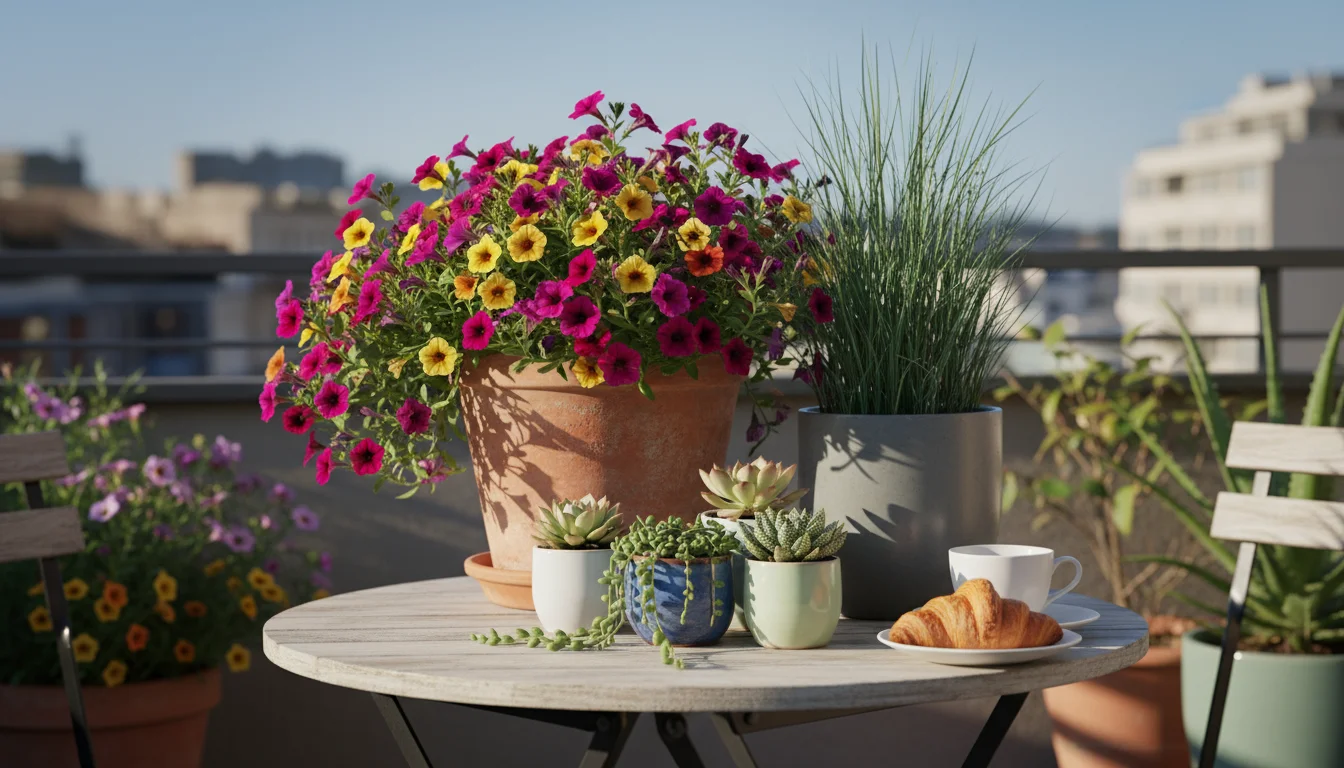
Low-Upkeep Plant Choices
The biggest factor in reducing maintenance is selecting resilient, low-needs plants. Avoid overly fussy varieties or those highly susceptible to pests and diseases in your specific microclimate. Opt for:
- Drought-tolerant plants: As mentioned, these require less frequent watering. Succulents, Mediterranean herbs, and many ornamental grasses are excellent choices.
- Slow-growing varieties: They require less frequent pruning. Consider dwarf shrubs or compact perennials.
- Pest-resistant plants: Some plants naturally deter common pests. Research local recommendations for your region.
- Self-cleaning annuals: Many modern petunias, calibrachoa, and impatiens are “self-cleaning,” meaning they drop spent flowers and do not require deadheading, saving you considerable time.
Remember to match plants to your balcony’s light conditions. A shade-loving plant in full sun will struggle, requiring more intervention.
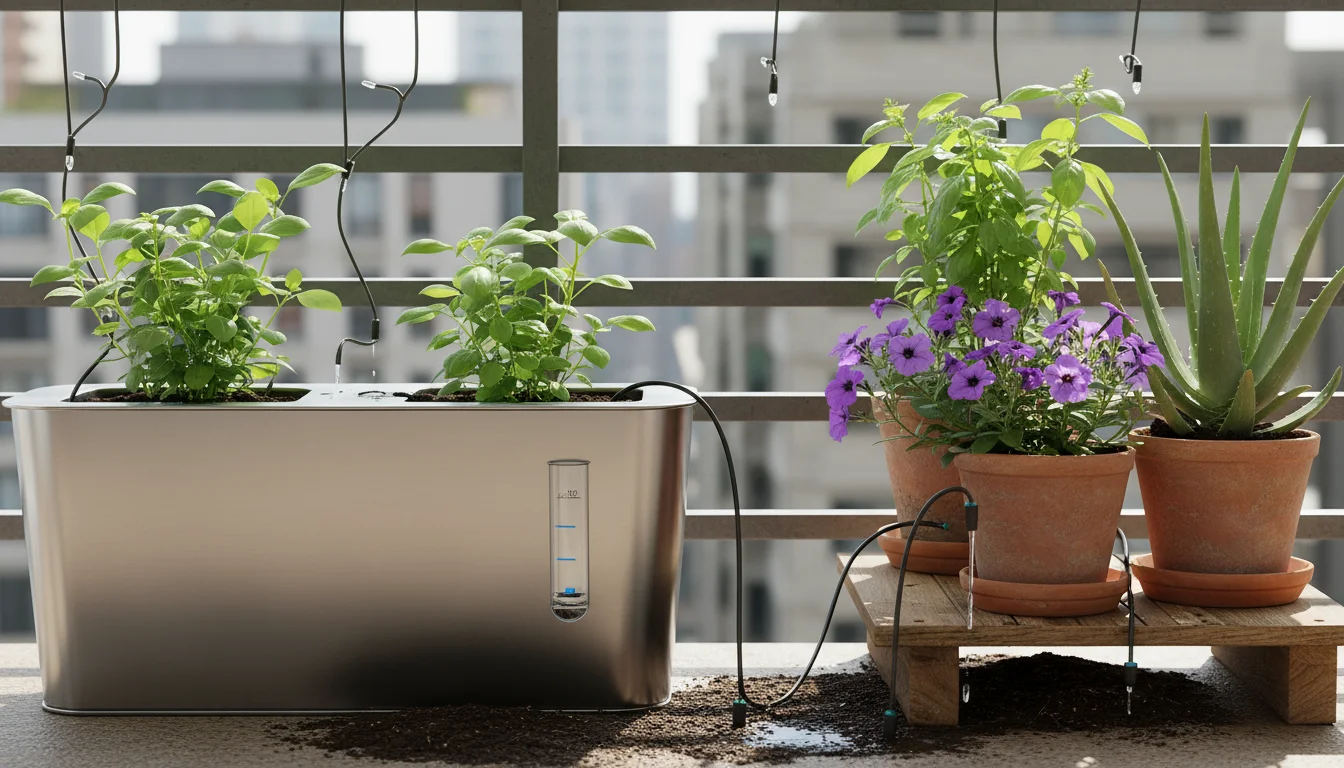
Establishing an Efficient Irrigation Rhythm
Consistent watering is crucial for container plants, but it does not have to be time-consuming. Design your watering strategy for efficiency:
- Self-Watering Planters: These containers have a built-in reservoir that wicks water up to the soil, significantly extending the time between waterings. They are excellent for busy gardeners.
- Drip Irrigation Systems: For larger balcony gardens, a small, automated drip irrigation system can be a game-changer. These systems deliver water directly to the plant roots, reducing waste and ensuring consistent moisture. Many kits are available for small spaces and are relatively easy to install.
- Grouping Plants: Arrange plants with similar water needs together. This prevents overwatering some plants while underwatering others.
- Morning Watering: Water early in the morning. This allows plants to absorb water before the heat of the day, minimizing evaporation and reducing the risk of fungal diseases.
Even without automated systems, establishing a consistent schedule and checking soil moisture daily with your finger ensures your plants receive what they need.
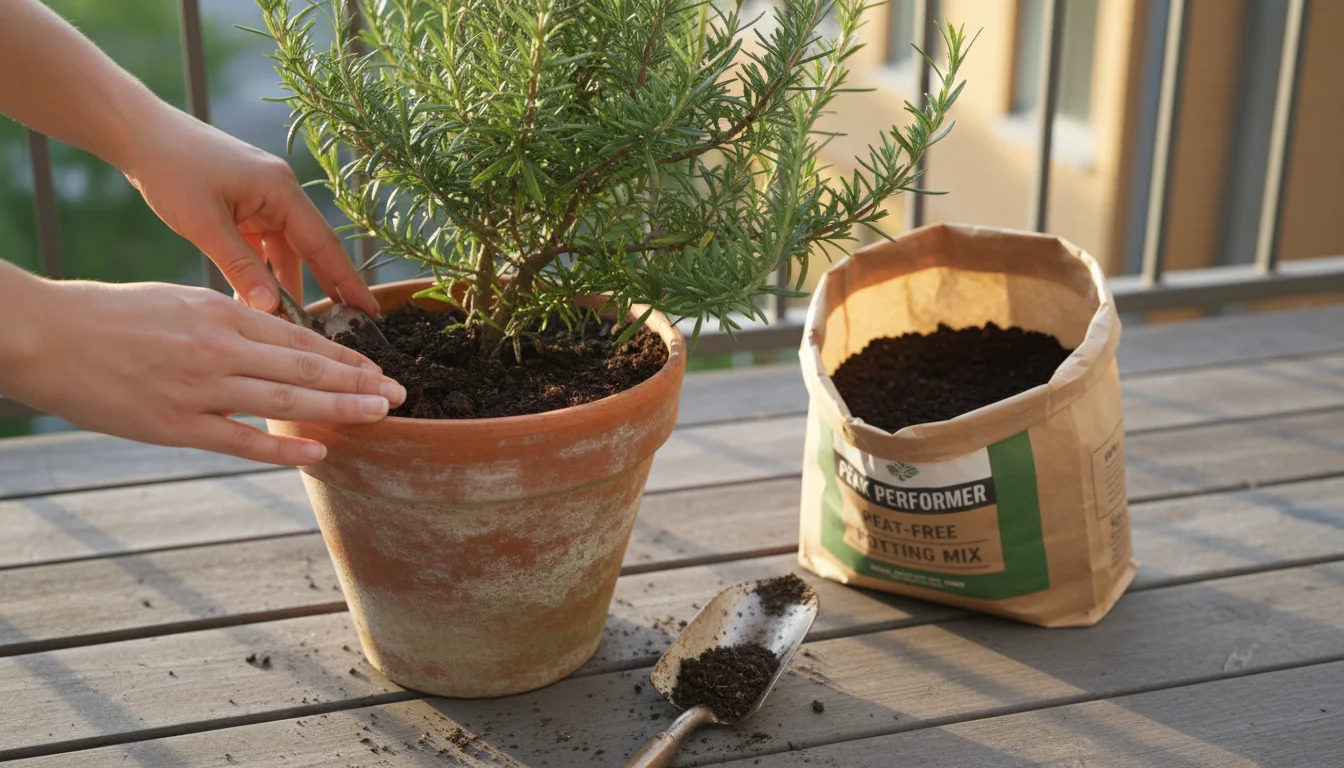
Potting Mix Refresh for Continued Vitality
Container plants deplete nutrients and compact their soil over time. Regular potting mix maintenance keeps your plants healthy and minimizes issues:
- Annual Top-Dressing: Each spring, remove the top few inches of old potting mix from your containers and replace it with fresh, nutrient-rich compost or new potting mix. This replenishes nutrients and improves soil structure.
- Repotting: Every 1-3 years, depending on the plant, repot into a slightly larger container with fresh potting mix. For plants that have reached their maximum container size, root prune and return them to the same pot with new soil.
Using high-quality, peat-free potting mix from the start provides a strong foundation for plant health.
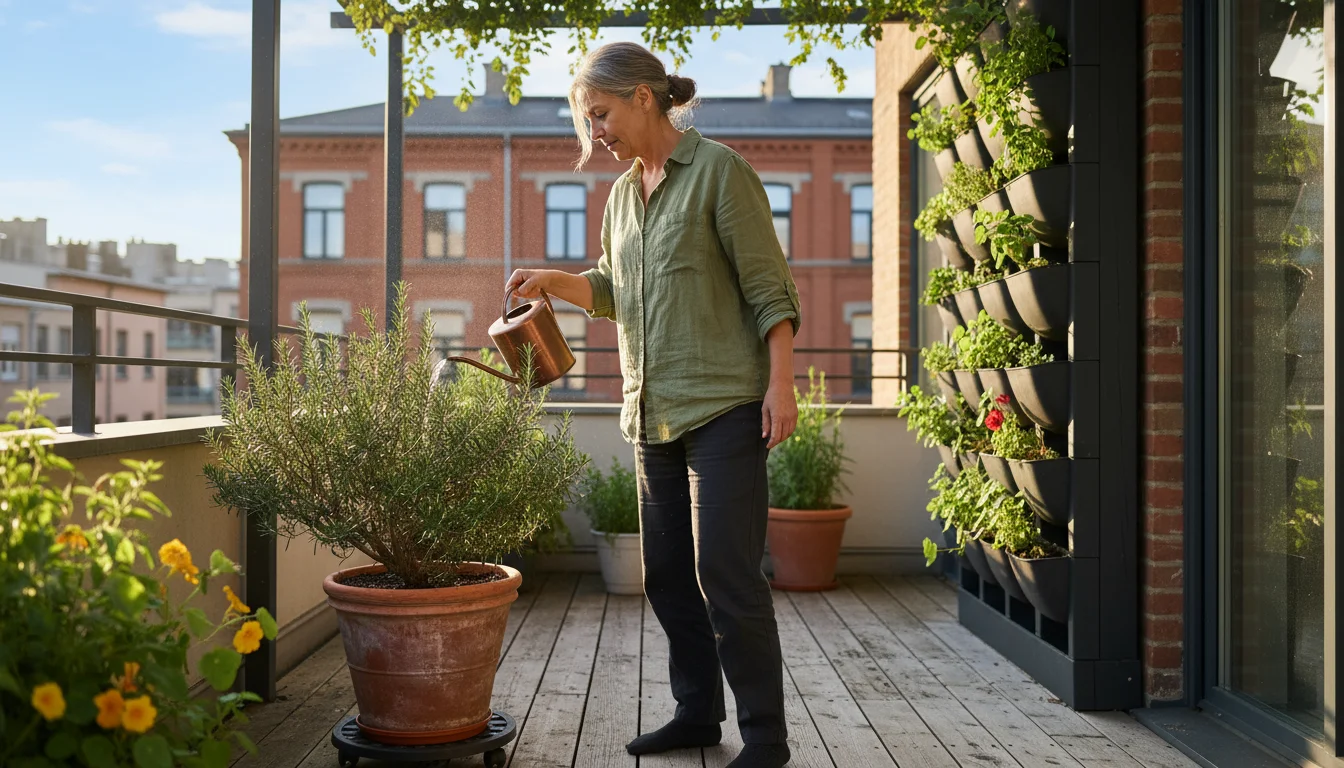
Designing for Accessibility
Ensure your balcony layout allows easy access to all your plants for routine care. Avoid placing pots in corners or behind heavy furniture where you struggle to reach them. If you use vertical planters, ensure they are at a comfortable height for watering and pruning. Wheeled plant caddies (as discussed earlier) significantly improve accessibility and flexibility for heavier containers.
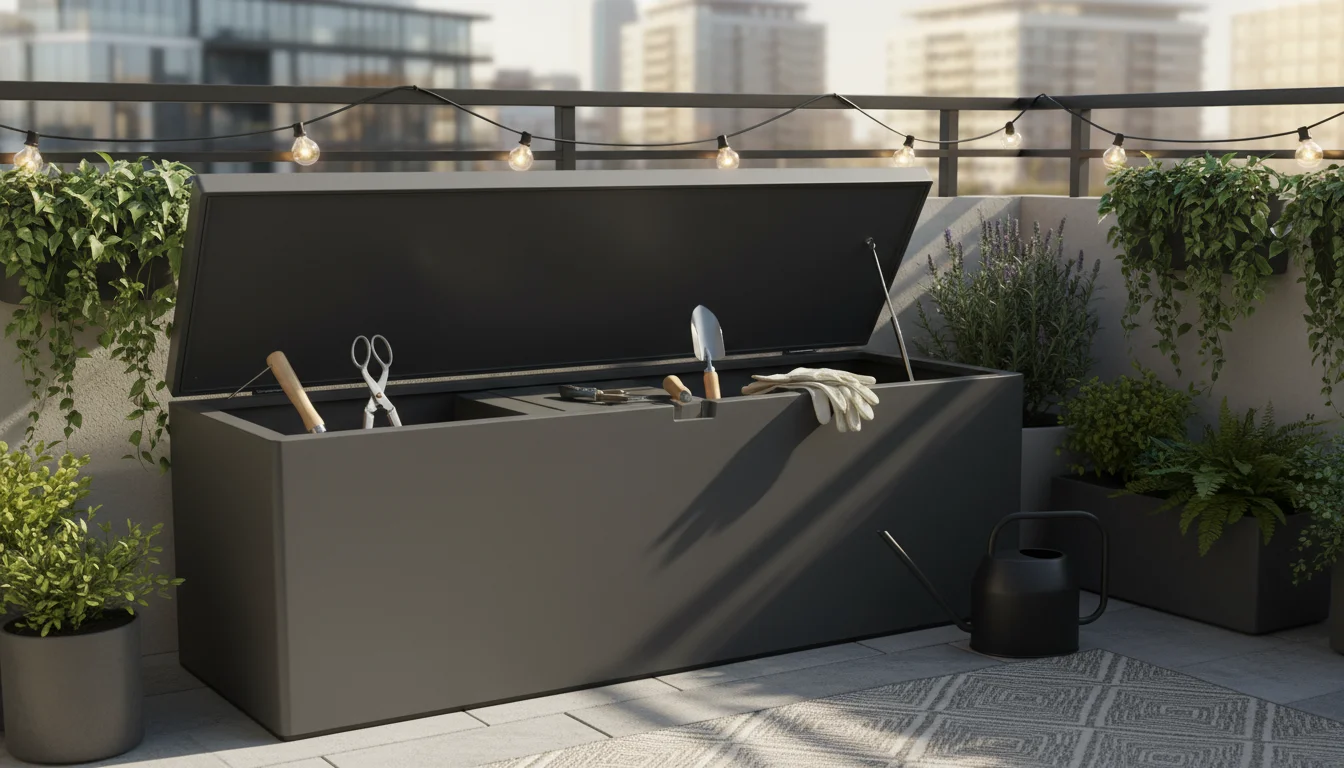
Integrated Tool Storage
Keep essential gardening tools handy but out of sight. A small, weather-resistant storage bench or a decorative garden caddy can discreetly hold pruning shears, a trowel, gloves, and a watering can. Having tools readily available encourages small, consistent maintenance tasks, preventing them from becoming overwhelming chores.
By integrating these maintenance considerations into your balcony garden design, you create an outdoor room that not only looks beautiful but also remains a source of relaxation and enjoyment, not endless work.
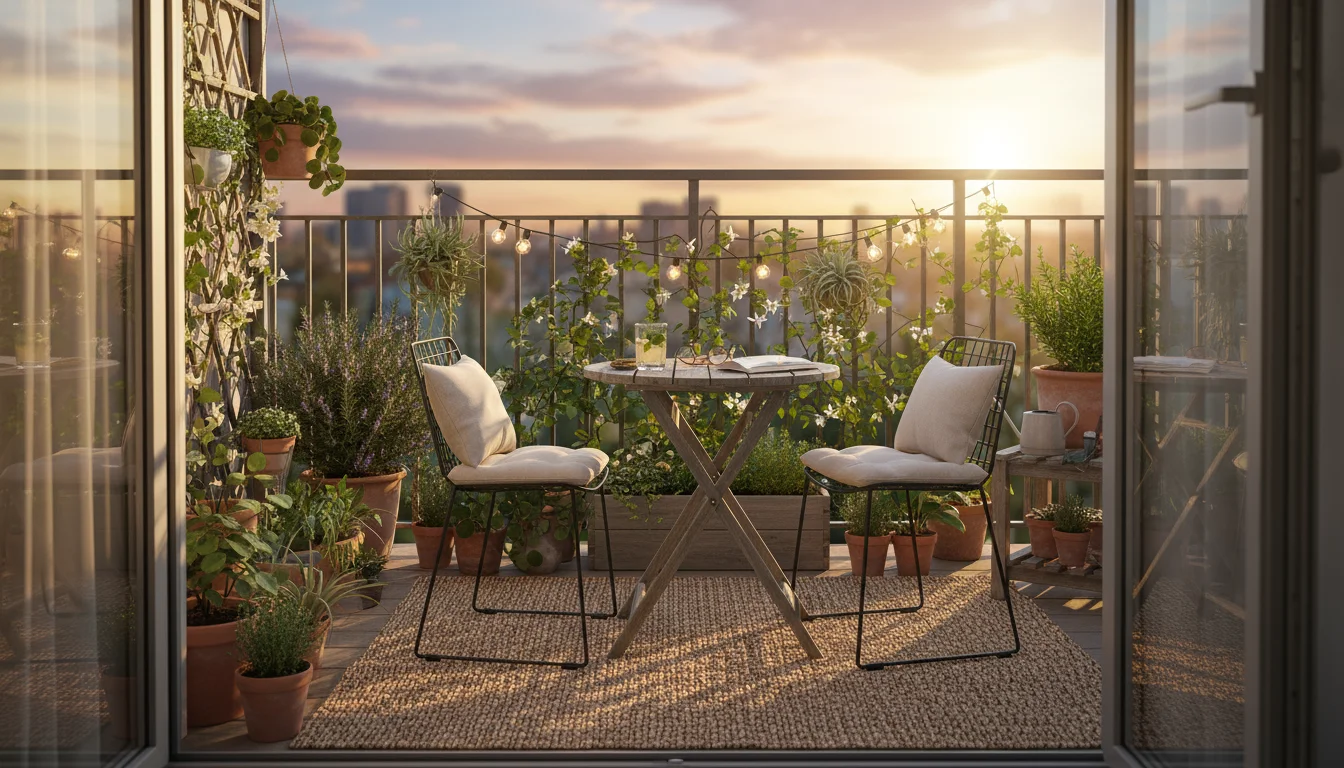
Frequently Asked Questions
How do I know if my balcony can support the weight of many pots?
Balcony weight limits vary significantly by building code and construction. Most modern balconies can safely support typical residential loads, but a large number of heavy, wet pots filled with soil can add substantial weight. A cubic foot of wet soil weighs roughly 80-100 pounds. It is always best to consult your building management or a structural engineer if you plan a very extensive container garden, especially with large, heavy ceramic or concrete planters. As a general rule, distribute weight evenly, and place the heaviest items closer to the building structure rather than along the outer edge.
What are the best plants for a shady balcony?
Many beautiful plants thrive in shade. For foliage, consider hostas, ferns (like maidenhair or autumn fern), coleus (with its vibrant leaf colors), impatiens, and ivy. For flowers, fuchsias, begonia (tuberous or wax), pansies, and lobelia perform well in shadier spots. Some herbs, such as mint and cilantro, also tolerate partial shade. The New York Botanical Garden offers excellent plant guides for various conditions; visit New York Botanical Garden for inspiration.
How often should I water my balcony plants?
There is no one-size-fits-all answer, as watering frequency depends on plant type, pot size, potting mix, weather, and sun exposure. Generally, container plants dry out faster than in-ground plants. Check the soil moisture daily by sticking your finger about an inch or two into the soil. If it feels dry, it is time to water. Water thoroughly until you see water drain from the bottom of the pot. Using larger pots, water-retentive potting mix, and self-watering planters can significantly reduce watering frequency.
Can I grow vegetables on a balcony?
Absolutely! Many vegetables thrive in containers. Choose compact or dwarf varieties suitable for pots. Ideal choices include cherry tomatoes, bush beans, leafy greens (lettuce, spinach), radishes, carrots (in deep pots), peppers, and herbs. Ensure your balcony receives at least 6-8 hours of direct sunlight per day for most fruiting vegetables. Even in partial shade, you can successfully grow leafy greens and some herbs. For detailed plant information, including growing conditions, check resources like Kew Science’s Plants of the World Online database at Kew Science – Plants of the World.
How do I protect my plants during winter?
Winter protection depends on your climate and plant hardiness. For tender annuals, you typically remove and compost them. For perennial plants, consider moving them indoors if they are in pots and small enough. For larger, hardier perennials and shrubs, insulate pots with bubble wrap, burlap, or a thick layer of mulch to protect roots from freezing. Ensure pots have excellent drainage to prevent waterlogging and subsequent root rot during cold, wet periods. In extremely cold climates, bringing containers into an unheated garage or shed can offer sufficient protection.
